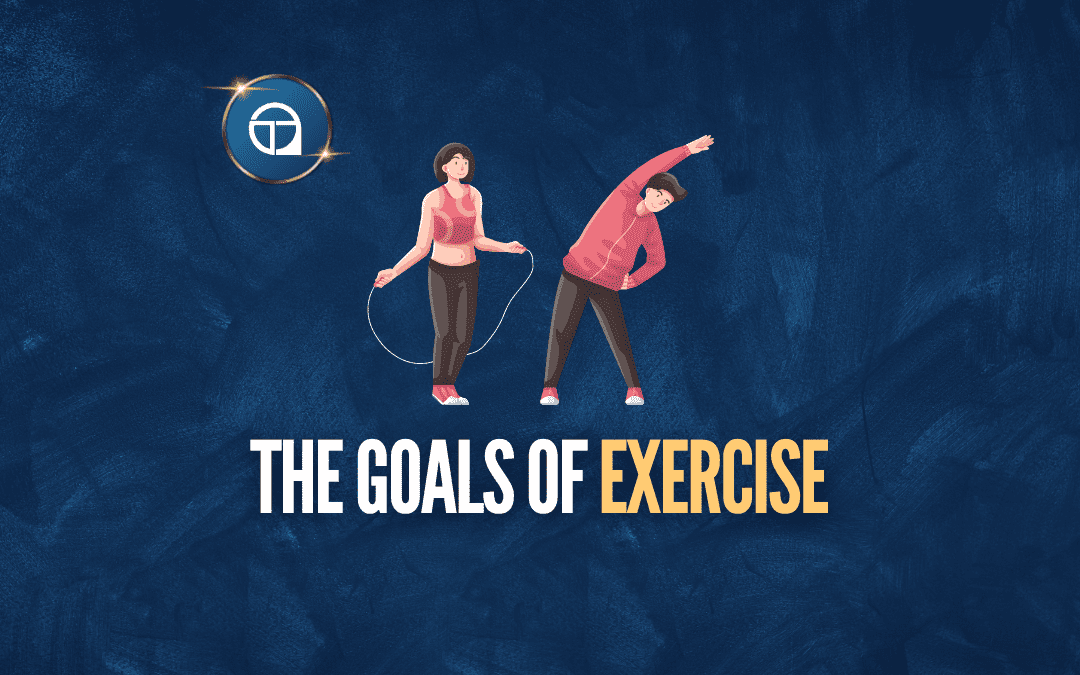Understanding the goals of exercise can really help you to make sense of an exercise program, and why you should include certain things in a program. Exercise is one of the pillars of “your best self”, although it is often the one that is neglected the most. Most people don’t exercise, and this is unfortunate, because exercise is incredibly important and is one of the most impactful things you can do to become your best self.
When coaching people, we very often spend a decent chunk of time at the start of the process, getting really clear on their goals. However, to then translate their goals into an actionable plan, we have to also be clear on what goals are accomplished by exercise, what goals are supported by exercise and ultimately, what we need to do with our exercise program to allow them to achieve their goals. So, to do this, we have to be clear on what goals exercise accomplishes and supports.
Before we get stuck in, I would just like to remind you that we offer comprehensive online coaching. So if you need help with your own exercise program or nutrition, don’t hesitate to reach out. If you are a coach (or aspiring coach) and want to learn how to coach nutrition, then consider signing up to our Nutrition Coach Certification course. We do also have an exercise program design course in the works, if you are a coach who wants to learn more about effective program design and how to coach it. We do have other courses available too.
Table of Contents
The Three Core Goals of Exercise
When we discuss exercise, much like nutrition, sleep and stress, we often discuss it in terms of how it helps us achieve the three core goals of health and fitness:
- Health
- Performance
- Your Optimal Body Composition
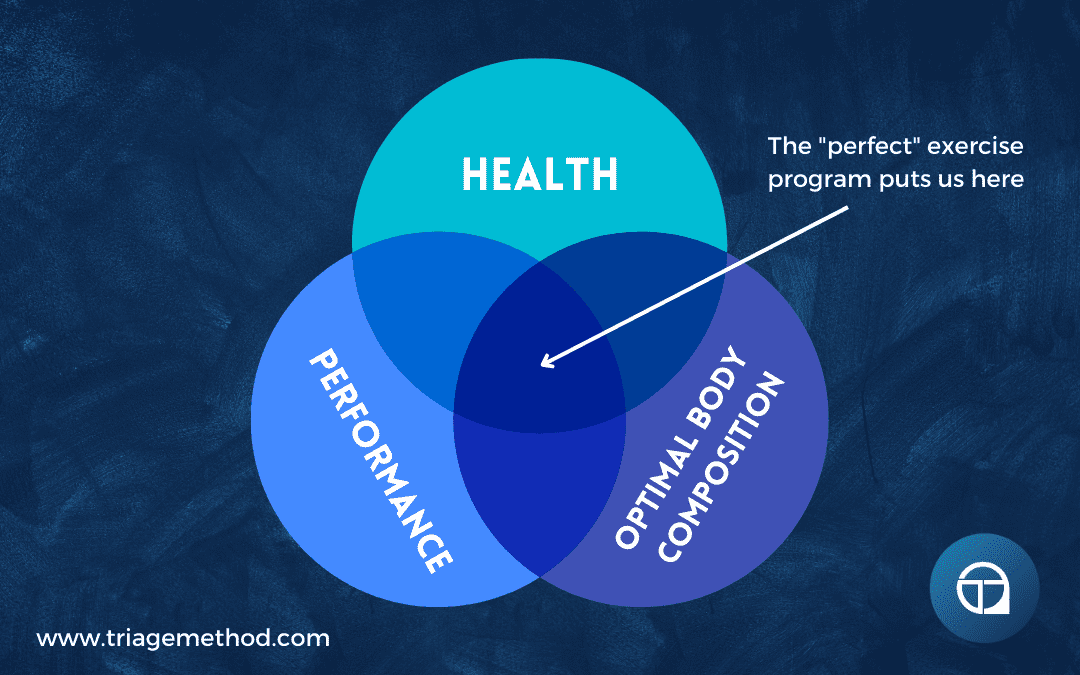
An effective exercise program can help contribute to better health, optimal body composition and improved performance (I know some people may be thinking about performance purely in terms of physical performance, but by performance, we also mean performance in all areas of life, such as cognitive and emotional performance).
The perfect exercise program would allow us to accomplish all three of these. However, very often exercise programs tend to prioritise one (or maybe two) of these goals at the expense of the other(s). You see this all the time, with exercise programs that are not structured with long-term health in mind, or that sacrifice performance in pursuit of lower body fat. This is important to understand, as it is very easy to get sucked into an exercise paradigm that isn’t actually helping you achieve all the goals you have.
Sometimes it is ok to prioritise one or two of these goals over the others, especially for short periods of time, but generally, it isn’t good to neglect any of these for long periods of time.
While we discussed this in the foundational nutrition article, it is important to define what we mean by these goals.
Health was previously defined as the absence of disease, and many people still think of it as such. I don’t know about you but I want to think of health as more than the absence of a state of disease. I want to feel as good as possible, I want my blood work to be perfect, and I want to radiate vitality. That is health. We can boil it down to numbers and figures on a page, but it is as much a mental as it is a physical state.
At Triage, we generally think of health as resilience to and against insults to your life and well-being.
Performance is both physical performance and mental performance. You should be able to do whatever you wish with your body. Need to run for the bus? Want to play with the kids? Need to lift up that heavy box? You should be able to. Your body should be able to perform in the ways you need it to, to make life easy for you. But so should your mental performance. You shouldn’t be feeling tired/dull or foggy-brained as soon as 3 o’clock rolls around. You should feel mentally acute all day. You should be waking up in the mornings with both mental and physical vigour. That’s what good performance is.
Your optimal body composition is the level of body fat and musculature that both allows you to feel and perform at your best, and also allows you to feel sexy and confident when you look in the mirror. People like hard and fast rules (you should be X% body fat) and we discuss specific targets elsewhere, but these are just very rough guidelines and aren’t specific to you as an individual. Optimal body composition is not something we define for you, it’s the optimal body composition that leaves you with the physique and health that you desire.
So when we think about our exercise program, we want to think in an outcome-based manner. We want our exercise program to be based on the outcomes we see before us. Not on some theoretical best practices or theoretical results, but rather, the actual results we see from the exercise we engage in. While generalised guidelines and understanding are important, you will need to tailor exercise programming to your individual needs.
If our exercise strategies aren’t working, something needs to change. There is no one-size-fits-all exercise program, and you will have to adjust your exercise program to your needs. This can be difficult, as it is a moving target. You see, the stuff you did to get to a certain level of fitness may not be the stuff you need to do to get to the next level of fitness.
So, while understanding the generic guidelines for exercise is a good start, what is actually really important for your long term progress, is an understanding of what you are actually trying to achieve with exercise. This allows you to better understand what tool is the best tool for the job (i.e. what type of exercise you need to prioritise for a specific adaptation) and how you will need to set up your exercise programming to actually achieve that goal.
The more meta goals of exercise are to improve health, performance and body composition. However, within these meta goals are more exercise specific goals, and working on these more exercise specific goals leads to outcomes that then in turn, influence the meta goals. So, while we do still need to understand what our priorities are with the more meta goals, if we want to actually influence those meta goals, we need to understand the exercise specific goals. We can actually get very granular with the exercise specific goals, however, it is most helpful to just lump these together in broader categories.
Exercise Specific Goals
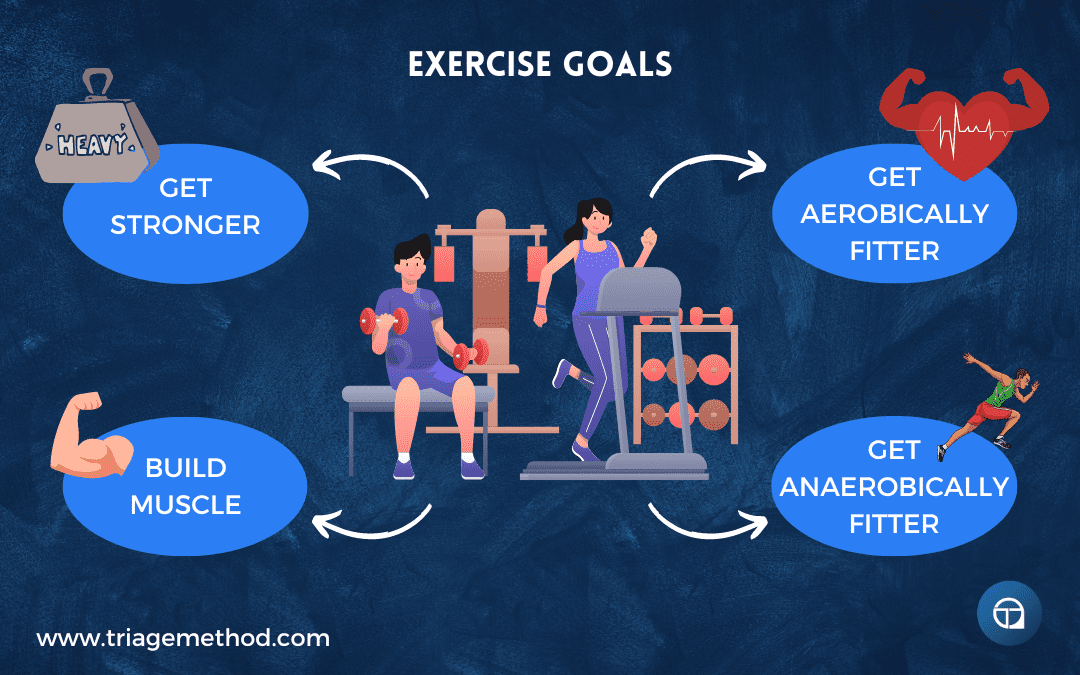
In general, the main exercise specific goal categories are:
- Improve strength
- Improve muscle mass
- Improve aerobic fitness
- Improve anaerobic fitness
There are also some peripheral goals to these, and specific individuals may have their own more specific goals (especially if they are engaged in specific sports), but these are the main categories of exercise specific goals.
Get Stronger
Strength is one of the major goals of exercise. Strength can be thought of as the ability of muscles to generate force against resistance. While we often think of strength in terms of resistance training and the ability to lift heavy weights, however, strength is essential for performing activities of daily living (walking up the stairs or standing up require strength, as does lifting boxes or moving furniture require strength) and sports performance (most sports benefit from a stronger body).
So it is probably better to think of strength as “what your muscles/body can actually do, as opposed to how big your muscles are or how your body looks”.
It is also important to realise that there are different “types” of strength. While most people in the fitness realm tend to think of strength as it relates to maximal strength, usually in the form of 1 rep maxes, and usually in the 3 exercises that are tested in powerlifting (the squat, bench press and deadlift), there are actually other types of strength.
Some of the most common types of strength include:
- Maximal Strength: Maximal strength refers to the maximum amount of force a muscle or muscle group can generate during a single maximal effort. It is typically assessed using exercises such as the squat, bench press, or deadlift, with heavy loads lifted for one repetition maximum (1RM). Maximal strength is important for tasks requiring maximal force production, such as powerlifting or lifting heavy objects near your limit strength (your limit strength is the absolute limit of your strength).
- Relative Strength: Relative strength is the amount of force produced by a muscle relative to body weight. It is often expressed as strength per unit of body weight (e.g., strength-to-weight ratio). Individuals with high relative strength can generate significant force relative to their body size and weight, making it particularly relevant in sports where body weight affects performance, such as gymnastics or combat sports.
- Muscular Endurance: Muscular endurance refers to the ability of a muscle or muscle group to sustain repeated contractions over an extended period without fatigue. It involves the capacity to resist muscular fatigue and maintain force output during prolonged or repetitive tasks. Muscular endurance is essential for activities requiring sustained effort, such as long-distance running, cycling, or endurance events.
- Explosive Strength (Power): Explosive strength, also known as power, is the ability to generate force quickly and produce rapid movements. It involves the combination of strength and speed and is crucial for activities requiring rapid acceleration, jumping, or throwing. Explosive strength is often expressed through exercises such as the vertical jump, sprinting, or Olympic weightlifting movements like the clean and jerk or snatch.
- Speed-Strength (Rate of Force Development): Speed-strength refers to the ability to rapidly develop force during a muscle contraction, known as the rate of force development (RFD). It emphasises the quickness of force production and is essential for tasks requiring rapid changes in direction, agility, or reactive movements. Speed-strength is particularly relevant in sports such as sprinting, jumping, or combat sports.
- Isometric Strength: Isometric strength is the ability to generate force without a change in muscle length or joint angle (i.e. the body looks like it isn’t moving, but the muscles are actively contracting in that position). It involves static contractions where muscles exert force against an immovable object or maintain a fixed position against resistance. Isometric strength is important for activities such pushing or pulling against a stationary object, holding onto an opponent in grappling or maintaining posture.
- Functional Strength: Functional strength refers to the ability to perform “everyday activities” and movement patterns efficiently and safely. It involves the integration of strength, stability, mobility, and coordination to carry out functional tasks such as lifting, carrying, pushing, pulling, and reaching. While different people have different definitions of what functional strength is, you can think of sports like strongman as being an expression of functional strength. Some people like to think of it in terms of isolation exercises versus exercises that require the coordination of multiple muscles. So a quad extension exercise wouldn’t be considered a functional exercise, but a squat would be. This thinking can be a bit misguided, as all strength is functional in that it allows for force generation from muscle(s), but it is helpful as a mental shortcut.
These different types of strength can be developed and improved through targeted training strategies that emphasise specific performance characteristics and training adaptations. So it is important to understand what you actually mean when you think about strength.
It is important because strength is generally specific. There is a huge skill component to strength and while working on getting stronger more broadly will generally improve a lot of the different types of strength, you do still have to practise the skill of expressing the type of strength you wish to express.
For example, improving your maximal strength won’t necessarily improve your isometric strength, and vice versa. Training your strength endurance likely won’t have as big of an impact on your maximal strength or explosive strength as would training those types of strength specifically.
So, while there is some degree of generalisability from just getting stronger, you do actually have to train the specific skill of strength expression. People make this mistake all the time where they go from training with heavy weights near their limit for low reps (i.e. practising maximal strength), to training with lighter loads for more reps to build muscle (we will discuss muscle building in a moment). After training like this for a number of weeks, they then try to lift heavy again and they find that they have gotten weaker! Well, the reality is that they likely didn’t actually get weaker, they just haven’t been practising the skill of lifting heavy weights as much. So it is important to remember that strength is specific, so our training needs to be targeted to the specific adaptations we wish to elicit.
When we discuss resistance training later in this article, we are going to mainly focus on developing your strength more generally, not focusing too much on any specific type of strength. This broad focus will develop the overall strength of the body, but if you have specific strength goals, there may be better ways to organise your exercise program.
There are many things that influence strength, and we must remember that strength in a specific exercise is the result of multiple different processes. Some of these are trainable, while others are just innate (i.e. you are born that way).
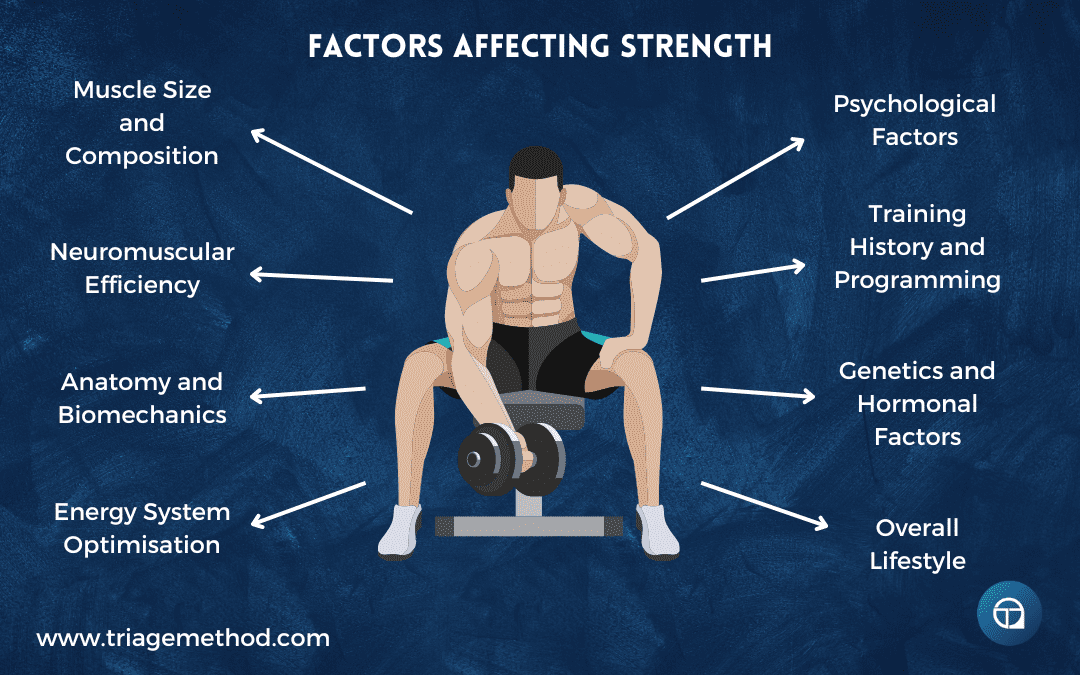
Some of the factors that influence your ability to express your strength include the following:
- Muscle Size and Composition: Muscle strength is closely tied to both muscle size and composition. Larger muscles typically possess a greater ability to generate force due to the increased number and size of muscle fibres they contain. Moreover, the ratio of fast-twitch (Type II) to slow-twitch (Type I) muscle fibres plays a crucial role in determining strength capabilities. Fast-twitch fibres are particularly adept at producing high-force, explosive movements, whereas slow-twitch fibres are better suited for endurance-related tasks.
- Neuromuscular Efficiency: Neuromuscular efficiency is crucial for optimal strength expression, requiring efficient coordination between the nervous system and muscles. By efficiency I mean the nervous system’s ability to recruit motor units and synchronise muscle contractions effectively. Enhanced neuromuscular efficiency leads to improved force production and movement coordination during strength-related tasks. Strength gains are largely attributed to neuromuscular adaptations, which involve enhancements in motor unit recruitment, synchronisation, and firing rate. As a result, you get increased motor unit activation and coordination, ultimately contributing to increased force production (i.e. you can contract harder) and improved movement efficiency (i.e. you are good at the skill of expressing that strength).
- Anatomy and Biomechanics: Anatomy, joint mechanics and biomechanical factors play a crucial role in determining how effectively muscles produce force across various movement patterns and joint angles. Factors such as muscle leverage, tendon stiffness, and joint stability significantly influence force production capabilities and movement efficiency. Strength levels can vary depending on the joint angle and muscle length during a movement. Muscles may exhibit different force-production capacities across different joint angles due to variations in leverage and muscle activation patterns. As a result, the range of motion required for a specific exercise or task can also influence strength expression. Strength levels may differ at different points within the range of motion, and while this is fairly generalisable (i.e. we all have very similar anatomy), there may be significant differences for some individuals in some movements that either reduce or increase their ability to express their strength.
- Energy Systems: Energy systems within the body supply the fuel needed for muscle contractions during physical activity, and their optimisation can lead to increased ability to express strength. In strength-related endeavours, especially those demanding maximal or near-maximal effort, the phosphagen system is primarily utilised, although the glycolytic system is also used. These systems rapidly supply energy for short-duration, high-intensity activities, however, it is the aerobic system that allows the rapid recovery of these systems, which is important for strength activities that must be performed multiple times (i.e. repeated sprints or multiple sets of an exercise).
- Psychological Factors: Psychological factors, such as motivation, confidence, focus, and arousal levels, all play a crucial role in an individual’s ability to express their strength. While the body does the lifting, the mind does actually need to believe it can do the lifting if we are to actually express our true strength.
- Training History and Programming: Training history and programming significantly impact strength capabilities. Past training experiences and adaptations influence an individual’s potential for strength development, and someone who has never performed an exercise or performed a 1 rep max is unlikely to be able to express their true strength potential. The design of the training program and the adaptations targeted play a crucial role in strength gains, with variables such as exercise selection, intensity, volume, frequency, and progression model all greatly influencing training outcomes and thus someone’s strength.
- Genetics: Genetic factors also play a significant role in determining an individual’s potential for strength development. This includes stuff like variations in muscle fibre composition, muscle architecture, tendon stiffness, and to some extent hormone levels, along with many other more obvious things (i.e. stuff related to your physical body). But genetics do also play a role in the more psychological stuff too, and you may have the best genetics for strength but if you have genetics that serve to make you unmotivated, lazy or to struggle with adherence to a plan, then you likely won’t achieve your ultimate strength capabilities. There are also some less obvious genetic factors, such as androgen receptor density and binding affinity, along with various other biochemical differences that determine your strength capabilities.
- Hormonal Factors: Hormones such as testosterone, growth hormone, insulin-like growth factor 1 (IGF-1), and cortisol all play roles in regulating muscle protein synthesis, muscle repair, and recovery from exercise, and thus your ability to express strength. You can really go down the rabbit hole with this, as even within the broader category of hormones, there are thousands of little variables that can actually affect your strength capabilities. Some of this is dictated by genetics, while a lot of it is dictated by your overall lifestyle habits.
- Lifestyle: It goes without saying that your overall lifestyle also affects your ability to get strong. If your nutrition, sleep and stress management aren’t dialled in, you likely won’t achieve your strength potential. Similarly, there are many socioeconomic factors that also contribute to your ability to reach your ultimate strength potential.
Overall, strength is multifaceted and is influenced by a multitude of factors. It is important to keep this in mind, as very often people will engage with the exact same training program, but get vastly different outcomes from it. The reality is that some people just aren’t built to reach the upper echelons of strength, and other people are going to get recklessly strong despite not trying that hard. Everyone wants to believe that they are a unique individual, but as soon as they are somewhat different to the norm, suddenly they feel like they have been hard done by.
The important thing to keep in mind is that you can get stronger, even if you won’t be the strongest human alive. It is all relative, and you should really only compare yourself to your past self and seek to improve over time. Having coached hundreds of people, I know it is very easy to get stuck in a bad mindset where you fall victim to comparing yourself to others. This generally just leads to demotivation and poorer progress, and is why they say “comparison is the thief of joy”.
The true goal is to find joy in the journey, not the destination. You don’t listen to your favourite song just to get to the end of it and say it is finished. Instead, you listen to your favourite song because you enjoy it. The people who make the most progress with their strength are generally the ones that learn to find joy in the actual process of getting stronger. It is rare that this joy is reached through comparing themselves to others. So don’t fall into this trap.
Build Muscle
Building more muscle mass is another very common goal of exercise. To build muscle, we want to effectively increase the size of our muscle cells and the components within those cells, resulting in an enlargement of the overall muscle cross-sectional area. While you can also increase the number of muscle cells (hyperplasia), this doesn’t seem to contribute meaningfully to overall muscle building.
In response to certain forms of exercise (notably resistance training), the body initiates a process called muscle protein synthesis (MPS), where new proteins are synthesised to repair and build new muscle myofibrils (the contractile components of muscle cells) and other protein structures within cells. However, muscles can also increase in size due to increases in the volume of sarcoplasm (the fluid and organelles surrounding the myofibrils). As a result, we classically think of muscle building as being one of two types:
- Myofibrillar Hypertrophy: This type of hypertrophy involves an increase in the size and number of myofibrils within muscle fibres. Myofibrils are responsible for muscle contractions, and an increase in their size and number contributes to greater force production and strength.
- Sarcoplasmic Hypertrophy: Sarcoplasmic hypertrophy involves an increase in the volume of sarcoplasm, the fluid and organelles surrounding the myofibrils within muscle fibres. While this type of hypertrophy does not directly contribute to increases in strength, it can result in greater muscle size (which indirectly may increase strength by improving leverage and making the individual weight more) and endurance capacity.
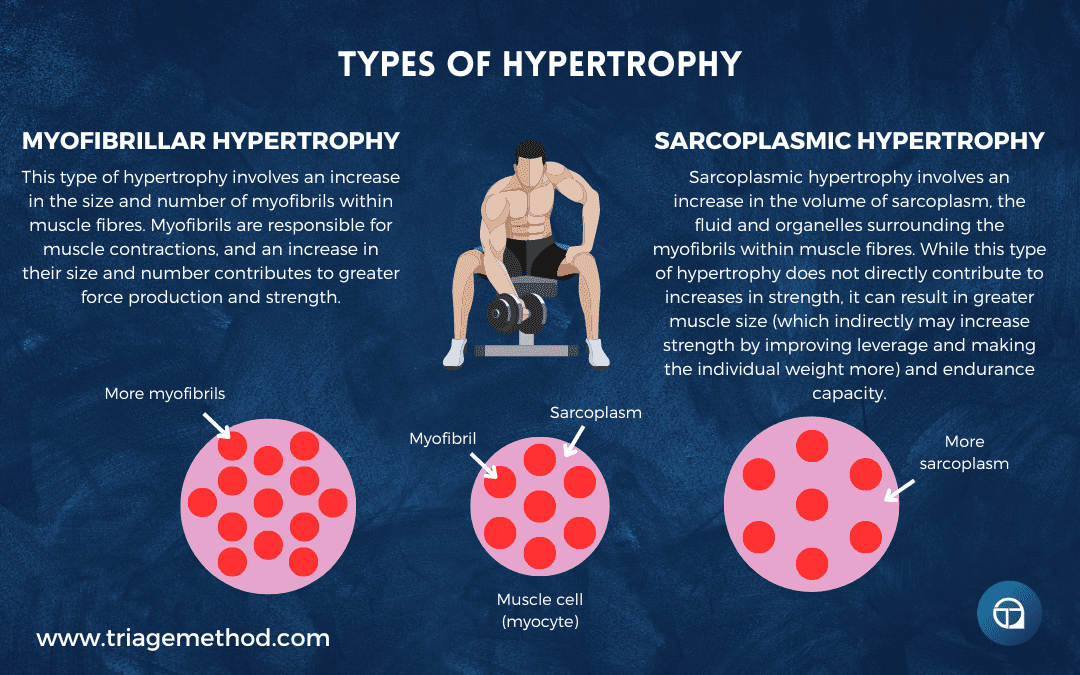
Now, it is important to realise that these aren’t clearly delineated, and usually, you will see some degree of both of them occurring when you engage in a good training program. So it isn’t important to focus on these too much, but it is important to know that you can build muscle in these two ways. It is important to know, because you often see people who are quite muscular, but who got that big by focusing on more sarcoplasmic hypertrophy. So these individuals may not be as strong as they look. Similarly, you often see individuals take performance-enhancing drugs and see a quick boost to their muscle cell volume, and thus muscle size, but as soon as they come off the drugs they lose this increased volume. But as I said, you don’t need to worry about this stuff too much.
Now, before moving on, I just want to briefly touch on the concept of “toned”. You see, toned is a word that is often used in the fitness industry, usually targeted at women who may not want to develop large amounts of muscle and thus may be put off by terminology such as building muscle mass. However, being toned is just having sufficient levels of muscle to provide shape, combined with relatively low levels of body fat. So to achieve this, you would still be working on building muscle, and you don’t need to do any specific “toning exercises” or “toning programs”. It is all just muscle building and thus the same principles apply, and the only difference is the overall quantity of muscle being built.
Interestingly, hypertrophy is kind of a side effect of training, rather than the main effect (which is to get stronger). However, you can bias muscle building by training in a manner that is more conducive to this side effect occurring, although, you do generally still need to get stronger to really maximise muscle building (we will discuss the concept of progressive overload later on).
Muscle hypertrophy is influenced by various factors, many of which overlap with the factors that affect strength, so we don’t need to delve into them again. Resistance training with moderate to heavy loads and sufficient volume, combined with adequate protein intake and proper recovery, is typically effective for stimulating muscle hypertrophy. You generally don’t actually need to do anything wild or exotic to build muscle, as it is a side effect of generally good program design. It is actually quite easy to build muscle, in theory at least.
However, most people find it difficult in practice because it generally takes a very long time (the maximum amount of muscle you are likely to build in a month is about 1kg if you are doing everything right and you are generally genetically well endowed for muscle building, although most people build significantly less than that).
It is helpful to understand what is actually causing muscle to be built in response to exercise, as understanding this does allow you to design better exercise programs and to know what you should be focusing on within a program. While we can get into the nitty gritty of the actual biochemical pathways of muscle growth, what is actually more helpful is understanding the three main vectors by which you can actually induce hypertrophy. These are:
- Mechanical Tension: Mechanical tension refers to the stress exerted on muscle fibres during exercise (notably resistance training). It is a key stimulus for muscle growth and involves the stretching and contracting of muscle fibres against resistance. Mechanical tension activates intracellular signalling pathways that promote muscle protein synthesis and hypertrophy. This is the pathway responsible for the majority of muscle growth, and should generally be the focus of exercise aimed at building muscle (i.e. you want to design a program that prioritises this, or at the very least doesn’t interfere with this).
- Muscle Damage: Muscle damage occurs as a result of mechanical stress placed on muscle fibres during exercise. Microscopic tears or disruptions in muscle fibres occur, triggering an inflammatory response and subsequent repair and remodelling processes. This repair process involves the activation of satellite cells, which proliferate and differentiate to repair damaged muscle fibres. Over time, repeated cycles of muscle damage and repair lead to muscle growth and hypertrophy. Muscle damage is often associated with eccentric (lengthening) muscle actions, such as lowering a weight under control during resistance exercises, and also seems to occur more when muscles are at longer lengths (i.e. the stretched position). Muscle damage in and of itself doesn’t necessarily lead to muscle hypertrophy, as evidenced by the fact that if you repeatedly hit your muscles with a hammer, they don’t grow bigger (outside of maybe growing bigger due to inflammation). So while it is implicated in the muscle building process, it doesn’t seem to be the main driver and it may just be going along for the ride.
- Metabolic Stress: Metabolic stress refers to the buildup of metabolites, such as lactate, hydrogen ions, and reactive oxygen species, within muscle cells during high-intensity or prolonged resistance training. These metabolites accumulate as a result of anaerobic metabolism and oxygen debt during intense muscular contractions. Metabolic stress is believed to contribute to muscle growth by stimulating intracellular signalling pathways involved in muscle protein synthesis. It also promotes cellular swelling and the release of growth factors, which may further enhance muscle growth. Metabolic stress is often induced by performing resistance training for high-repetitions and multiple sets, usually also using short rest intervals, and potentially also incorporating techniques such as drop sets, supersets, or occlusion training. Metabolic stress may preferentially be stimulating hypertrophy due to sarcoplasmic hypertrophy, rather than myofibrillar hypertrophy.
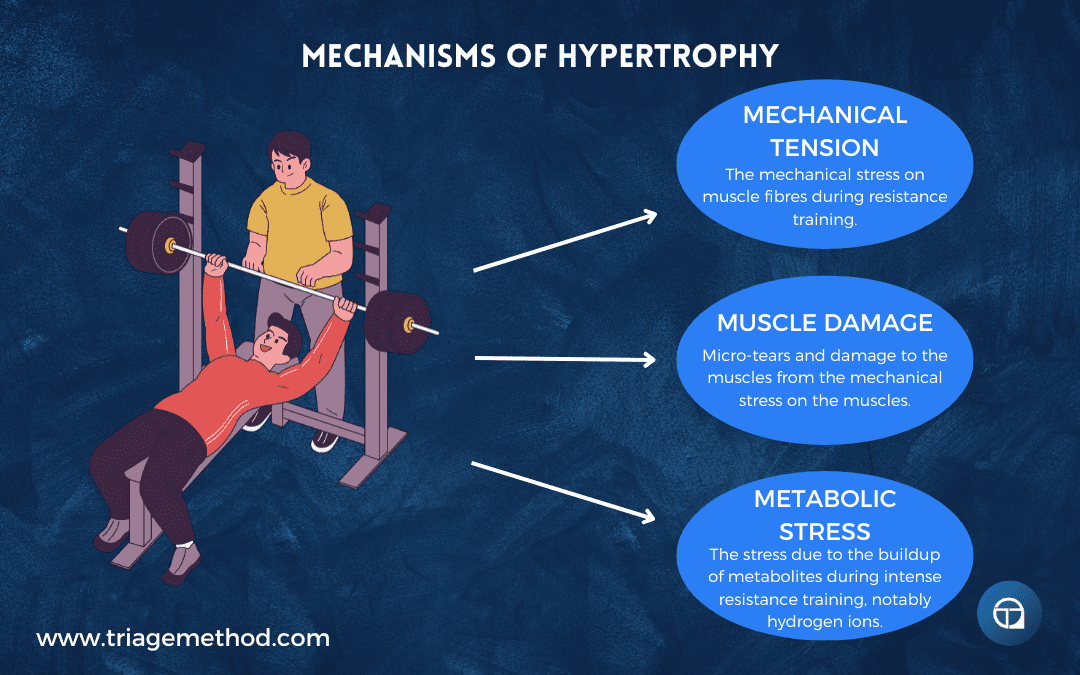
Improve Aerobic Fitness
While the last two major goals have been more on the strength side of the continuum, a lot of people also have more cardiovascular related goals. Many people have the goal of “getting fitter”. However, getting fitter is a bit of a nebulous term, as there are so many things that contribute to fitness, and fitness is specific to the task (i.e. fitness for a marathon runner is different from fitness for a combat athlete). But we do still need to have some way to discuss these “fitness” goals. So I am going to just break them down into aerobic and anaerobic fitness, however, do realise that much like with strength and muscle mass, there are further subcategories within these.
Aerobic fitness refers to the body’s ability to efficiently utilise oxygen during prolonged physical activity, and generally, it is discussed in opposition to anaerobic fitness. Anaerobic fitness refers to the body’s ability to perform high-intensity, short-duration activities without relying on oxygen in energy metabolism. So you can think of the aerobic system as the system that utilises oxygen, and the anaerobic system as the system that doesn’t utilise oxygen. We will discuss anaerobic fitness more in a moment, but for now, I want to focus on aerobic fitness.
As noted, the aerobic system is the system that utilises oxygen in energy metabolism. Aerobic metabolism is one of the three primary energy systems in the human body responsible for generating energy. It relies on the availability of oxygen to produce adenosine triphosphate (ATP), the primary energy currency used by cells for various physiological processes, including muscle contractions.
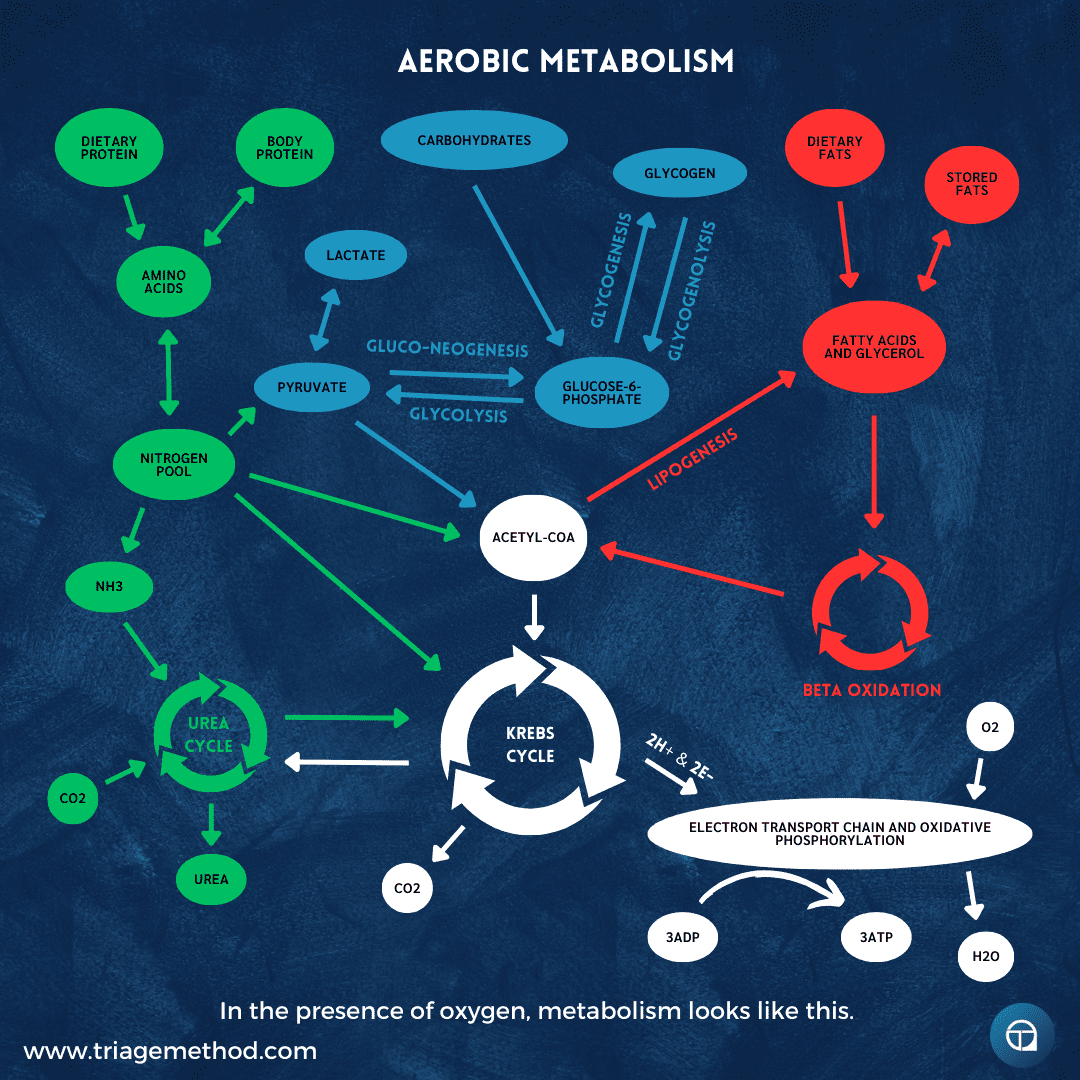
Key features of the aerobic system include:
- Oxygen Dependence: The aerobic system requires oxygen to break down carbohydrates, fats, and, to a lesser extent, proteins, in a process known as cellular respiration. Oxygen is transported from the lungs via the bloodstream to cells, and then to the mitochondria within cells, where aerobic metabolism occurs.
- Energy Substrate Flexibility: The aerobic system primarily utilises carbohydrates and fats as energy substrates. Carbohydrates are broken down into glucose, which enters the mitochondria and undergoes aerobic glycolysis and the citric acid cycle (Krebs cycle) to produce ATP. Fats are broken down into fatty acids and undergo beta-oxidation to generate ATP through aerobic metabolism. Generally, the aerobic system preferentially uses fats for fuel, although this isn’t always the case. Conversely, the anaerobic system can’t really utilise fats as an energy substrate.
- High Efficiency: Compared to the anaerobic energy system, the aerobic system has a higher energy yield per molecule of substrate and can sustain energy production for longer durations. You get more bang for your buck with the aerobic system, however, aerobic metabolism occurs at a slower rate and cannot generate energy as rapidly as anaerobic metabolism (which is why anaerobic metabolism is used to fuel high-intensity activities).
- Mitochondrial Utilisation: Aerobic metabolism predominantly occurs within the mitochondria, the cellular organelles responsible for producing ATP through oxidative phosphorylation. Mitochondria contain enzymes and electron transport chains involved in the breakdown of substrates and the synthesis of ATP in the presence of oxygen.
- Duration and Intensity: The aerobic system is most active during prolonged, steady-state activities lasting longer than a few minutes, such as walking, jogging, cycling, swimming, or endurance-based sports. It provides a continuous and sustainable supply of energy over extended periods, making it the primary energy source for activities lasting more than a few minutes. It is also generally the primary energy system used at rest.
While we often discuss aerobic fitness in terms of energy metabolism (as this is the key hallmark of aerobic metabolism), aerobic metabolism does actually require the elegant coordination of multiple bodily systems.
These include the following:
- Respiratory System
- Cardiovascular System
- Cellular Metabolism
- Organ Systems (notably the muscles and the liver)
- Nervous System (both to coordinate all these disparate systems, but also in relation to movement efficiency)
We can really go down the rabbit hole discussing these, and there are multiple subcomponents within these, and thus multiple very specific adaptations we could target. We won’t cover all these here, as this isn’t the purpose of this article, however, I do want you to have a bit of a high-level understanding of what some of these mean, as it does improve your ability to design better training programs.
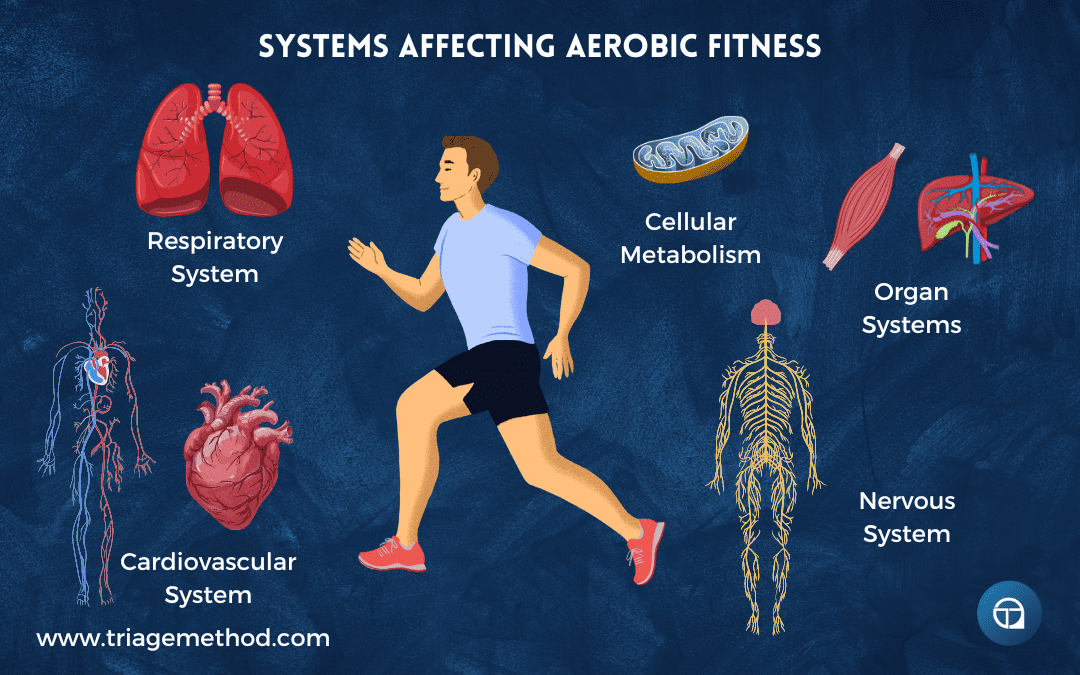
Respiratory System: Aerobic fitness depends on the efficiency of the lungs and respiratory system to get oxygen to the cells, while also removing the waste product carbon dioxide (and to an extent water). Having a higher respiratory efficiency enables the lungs to take in more oxygen and expel carbon dioxide more effectively, which in turn supports prolonged aerobic activity. Aerobic fitness also depends on your overall aerobic power (often called aerobic capacity or VO2 max), which is the maximum volume of oxygen that you can utilise during intense exercise. It reflects the body’s ability to transport oxygen from the atmosphere to the muscles, deliver oxygenated blood to working tissues, and utilise oxygen for energy production during exercise. We can think of it as the limit of your body’s ability to use the aerobic system. Inherently, if you can’t deliver oxygen to your cells or you can’t utilise that oxygen, you are going to have to shift into anaerobic (i.e. without oxygen) metabolism. There are multiple subcomponents with the category of the respiratory system that influence aerobic fitness, including:
- Lung Capacity and Function: The lungs are the primary organs of the respiratory system responsible for gas exchange. During aerobic exercise, the lungs facilitate the intake of oxygen (O2) from the atmosphere and the removal of carbon dioxide (CO2) produced by metabolic processes in the body. Efficient pulmonary function is essential for maintaining adequate oxygenation of the blood and removing waste gases during exercise. Lung capacity refers to the total volume of air that the lungs can hold, while lung function encompasses various parameters such as vital capacity, forced expiratory volume, and peak expiratory flow rate. Optimal lung capacity and function are essential for maximising respiratory efficiency and aerobic performance. Enhanced respiratory muscle strength, lung compliance, and gas exchange efficiency all can improve lung capacity and function, and thus aerobic fitness.
- Gas Exchange in Alveoli: Gas exchange occurs in the alveoli, tiny air sacs in the lungs where O2 diffuses into the bloodstream and CO2 diffuses out of the bloodstream. Efficient gas exchange depends on factors such as the surface area of alveoli, the thickness of the respiratory membrane, and the partial pressures of O2 and CO2 in the lungs and blood. Adequate gas exchange ensures the delivery of oxygenated blood to working muscles and the removal of CO2 generated during aerobic metabolism.
- Ventilation (Breathing Rate and Depth): Ventilation refers to the volume of air moved into and out of the lungs per minute and is determined by breathing rate (respiratory frequency) and tidal volume (the volume of air inspired and expired with each breath). During aerobic exercise, ventilation increases to meet the oxygen demands of working muscles and facilitate the removal of metabolic byproducts such as CO2. Optimal ventilation is crucial for maintaining respiratory efficiency and gas exchange during exercise.
- Respiratory Muscles: The diaphragm and intercostal muscles are the main respiratory muscles involved in breathing, along with accessory muscles (e.g. pectoralis major, upper trapezius, scalenes) during laboured breathing. These muscles contract and relax to create changes in thoracic volume, leading to inspiration (inhaling air into the lungs) and expiration (exhaling air out of the lungs). Strong and well-conditioned respiratory muscles contribute to efficient breathing mechanics and respiratory endurance during aerobic exercise.
Cardiovascular System: Aerobic fitness is highly dependent on the ability of the heart and vascular system (along with the respiratory system) to deliver oxygen-rich blood to the working muscles and other cells, and of course, bring that blood back to the lungs to allow carbon dioxide to be removed. Ultimately, if you can’t pump blood, and thus oxygen, to the cells efficiently, you are going to have poorer aerobic fitness. There are multiple subcomponents within the category of the cardiovascular system that influence aerobic fitness, including:
- Cardiac Output (CO): Cardiac output refers to the volume of blood ejected by the heart per minute. It is calculated by multiplying stroke volume (the volume of blood ejected per heartbeat) by heart rate (the number of heartbeats per minute). During aerobic exercise, cardiac output increases to meet the oxygen demands of working muscles, facilitating greater oxygen delivery and utilisation.
- Stroke Volume (SV): Stroke volume is the amount of blood pumped out of the heart with each heartbeat. It is influenced by factors such as preload (the amount of blood returning to the heart), contractility (the force of myocardial contraction), and afterload (the resistance the heart must overcome to eject blood into the arteries).
- Heart Rate (HR): Heart rate, measured in beats per minute, reflects the frequency of heart contractions and influences cardiac output. During aerobic exercise, heart rate increases to accommodate the greater oxygen demands of working muscles. Regular aerobic exercise can improve heart rate regulation, resulting in lower resting heart rates.
- Ejection Fraction (EF): Ejection fraction represents the proportion of blood ejected from the left ventricle during systole (heart contraction) and is a measure of cardiac contractility and pump function. A higher ejection fraction indicates greater ventricular efficiency and cardiovascular performance, as you are able to pump more blood out of the heart with each heartbeat.
- Vascular Compliance and Venous Return: Vascular compliance refers to the ability of blood vessels to expand and contract in response to changes in blood pressure and flow. Adequate vascular compliance ensures efficient blood flow distribution, optimal tissue perfusion, and reduced cardiac workload during exercise. Improved vascular compliance occurs due to vasodilation, enhanced endothelial function, and reduced arterial stiffness. Venous return refers to the rate of blood flow returning to the heart from the venous circulation. Optimal venous return ensures adequate preload and ventricular filling, supporting stroke volume and cardiac output during exercise. Venous return is influenced by skeletal muscle pump activity, blood volume, and venous compliance.
- Systemic Blood Pressure: Blood pressure, specifically systolic and diastolic pressures, reflects the force exerted by circulating blood against the walls of arteries during cardiac cycles. Adequate blood pressure regulation is essential for maintaining perfusion pressure and oxygen delivery to tissues during aerobic exercise. Blood pressure is influenced (in the context of aerobic exercise) by vascular tone, peripheral resistance, and cardiac function.
Cellular Metabolism: Aerobic fitness is also heavily influenced by cellular metabolism, and the efficiency of cellular metabolism. Metabolic efficiency involves the efficient utilisation of energy substrates (carbohydrates and fats) for aerobic metabolism. It reflects the body’s ability to oxidise and utilise fuels effectively to support aerobic exercise. There are multiple components that influence cellular metabolism, and the efficiency of cellular metabolism. We certainly don’t need to discuss all the intricacies of these, but it does help to have a very brief overview understanding of the kinds of things that go into metabolic efficiency in this context. The basic premise is that the stuff that goes on inside the cell, which serves to convert the food you eat and energy you store (as glycogen and fat) into usable energy in the form of ATP, can be optimised to support aerobic metabolism. There are a number of ways this process can be influenced, including:
- Mitochondria Number and Efficiency: Mitochondria are the cellular organelles responsible for aerobic metabolism and ATP production through oxidative phosphorylation. Which basically means that mitochondria play a central role in converting fuel substrates (i.e. carbohydrates and fats) and oxygen into usable energy in the form of ATP. Aerobic exercise training stimulates mitochondrial biogenesis, increasing the number and efficiency of mitochondria within muscle cells, which enhances aerobic capacity and endurance. To be at peak fitness, we want lots of mitochondria, and to have these mitochondria be very efficient.
- Aerobic Enzyme Efficiency: Various enzymes are involved in aerobic metabolism pathways, including aerobic glycolysis, beta-oxidation, the citric acid cycle (Krebs cycle), and the electron transport chain. Aerobic exercise training can upregulate the expression and activity of key aerobic enzymes, improving metabolic efficiency and energy production during prolonged exercise.
- Efficient Substrate Utilisation: Aerobic exercise relies on the oxidation of carbohydrates and fats as primary fuel substrates to generate ATP. Carbohydrates are stored as glycogen in muscle and liver tissues, while fats are stored as triglycerides in adipose tissue, and there is usually some level of glucose and fatty acids circulating in the blood, depending on when you last ate. During aerobic exercise, the body utilises a combination of carbohydrates and fats to meet energy demands, with the relative contribution of each substrate depending on exercise intensity, duration, and individual metabolic factors. Generally, lower intensity activities are fuelled by fatty acids primarily, and higher intensity activities are fuelled by glucose. In individuals who are aerobically fitter, specific metabolic adaptations occur that enhance the utilisation of fats for energy, sparing glycogen stores and delaying fatigue during prolonged exercise. Ultimately, when aerobically fit, we see improved substrate oxidation capacity, the ability to continue using fatty acids for fuel even after long durations and higher intensities, enhanced glycogen storage and delayed utilisation, and greater efficiency of substrate utilisation.
Organ Systems and Nervous System: Aerobic fitness is also determined by the various organ systems involved, including the ones we have already discussed such as the heart and lungs, along with the liver, and of course the muscles themselves. Muscular endurance in particular plays a key role in aerobic fitness by enabling the muscles to sustain repeated contractions over extended periods. It involves the ability of skeletal muscles to resist fatigue and maintain force output during continuous aerobic exercise. Some of this is due to the aforementioned cellular adaptations, but some of it is due to the nervous system coordinating the movements better. As a result of these cellular adaptations and greater muscular efficiency, fitter individuals are able to exercise and move in a much more efficient manner, thus wasting less energy.
So there is a lot that goes into aerobic fitness.
Aerobic exercise is generally thought of as exercise that is more continuous in nature, such as jogging, cycling, or swimming, but you can actually do most activities aerobically, once you stay within certain parameters.
In general, aerobic exercise is considered to be exercise that stays below a certain level of lactate in the blood. This is generally correlated with specific heart rates, as measuring blood lactate is difficult to practically measure, however, heart rate isn’t perfectly correlated with blood lactate.
Aerobic fitness is typically measured through various methods, including:
- VO2 Max (a higher VO2 max is associated with higher aerobic fitness)
- Resting heart rate (RHR) (a lower RHR is associated with higher aerobic fitness)
- Heart rate variability (HRV) (a higher HRV is associated with higher aerobic fitness, although this is largely a function of a lower RHR)
- Talk test and/or subjective measures at certain heart rates (if you can talk relatively easily and feel like exercise is easy at higher heart rates, it is likely that you are more aerobically fit)
While these don’t capture absolutely everything, they do give us some idea of someone’s aerobic fitness.
One final thing I want to mention about aerobic fitness is that it is the aerobic system that allows you to recover quickly and efficiently following effort. The body’s ability to restore energy reserves, remove metabolic byproducts, and recover the muscles is a function of aerobic fitness. This is important to keep in mind, as being aerobically fitter allows you to recover more quickly between exercise sessions, but it also allows you to recover more quickly between bouts of higher exertion. For example, it is the aerobic system that is responsible for recovery between sets of resistance training exercises, along with recovery between repeated sprint efforts, and anaerobic efforts more generally.
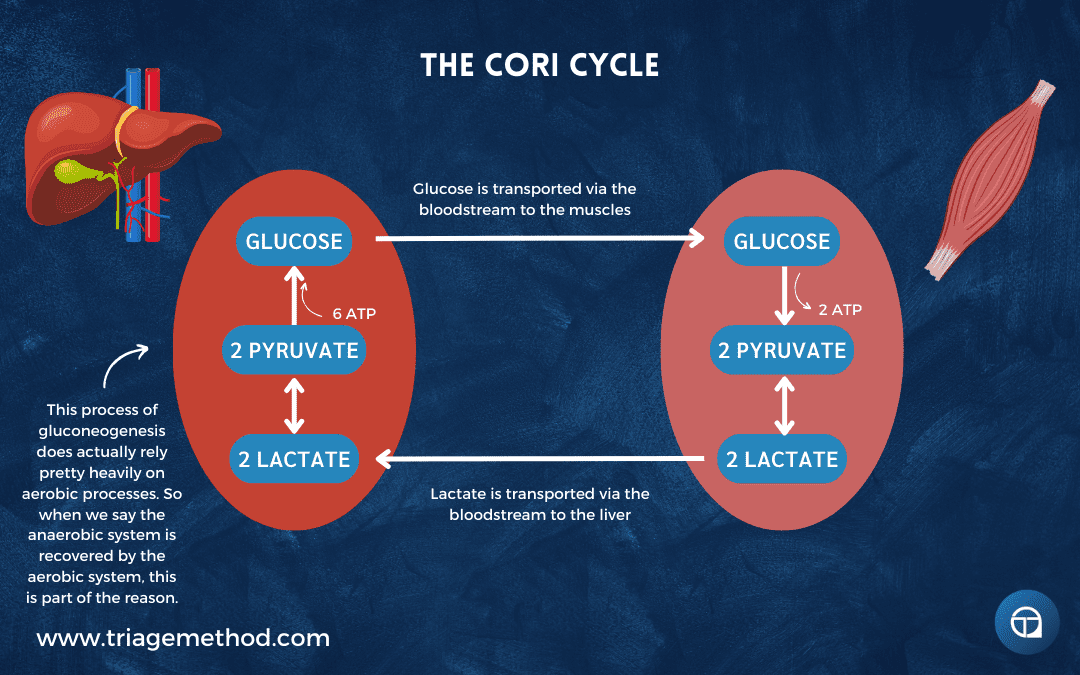
Improve Anaerobic Fitness
So you have a better understanding of aerobic fitness now, but that is not the only kind of fitness goal that people have. Some individuals want to improve their anaerobic fitness specifically. Anaerobic fitness refers to the body’s ability to perform high-intensity, short-duration activities without relying on oxygen in energy metabolism. Unlike aerobic fitness, which primarily involves sustained, endurance-based activities, anaerobic fitness generally emphasises quick bursts of intense effort that exceed the body’s ability to supply oxygen to the muscles. Most of you have likely sprinted as hard as you can, and felt that burning sensation in your muscles and maybe even in your lungs, along with the subsequent gasping for air. This is the anaerobic system at work (well, the gasping for air is to fuel the aerobic system recovering the anaerobic system, but I digress).
Most people think of anaerobic activities as stuff like sprinting, wrestling, and generally things that are more explosive in nature, however, this isn’t always the case. Someone who is severely unfit may find that walking is more of an anaerobic endeavour for them, because they are not able to fuel that activity with purely (or at least predominantly) aerobic systems. It is also important to keep in mind that the anaerobic system is generally only able to fuel activity for 30-120 seconds, and after that, the aerobic system starts to take over. This is why you don’t see people sprinting a marathon, as sprinting for this long simply can’t be fuelled efficiently. There are different types of anaerobic fitness, and clearly, someone who sprints the 100m is optimising for something different than someone who sprints the 400m, and something different again from someone who does 3-5 rounds of a combat sport, and something different again from someone who is engaged in repeated sprints such as you may see in field sports like football. So we can get a bit more granular by what we mean by anaerobic fitness, however, this is generally only of concern for individuals engaging in sports, so we will cover it in other articles.
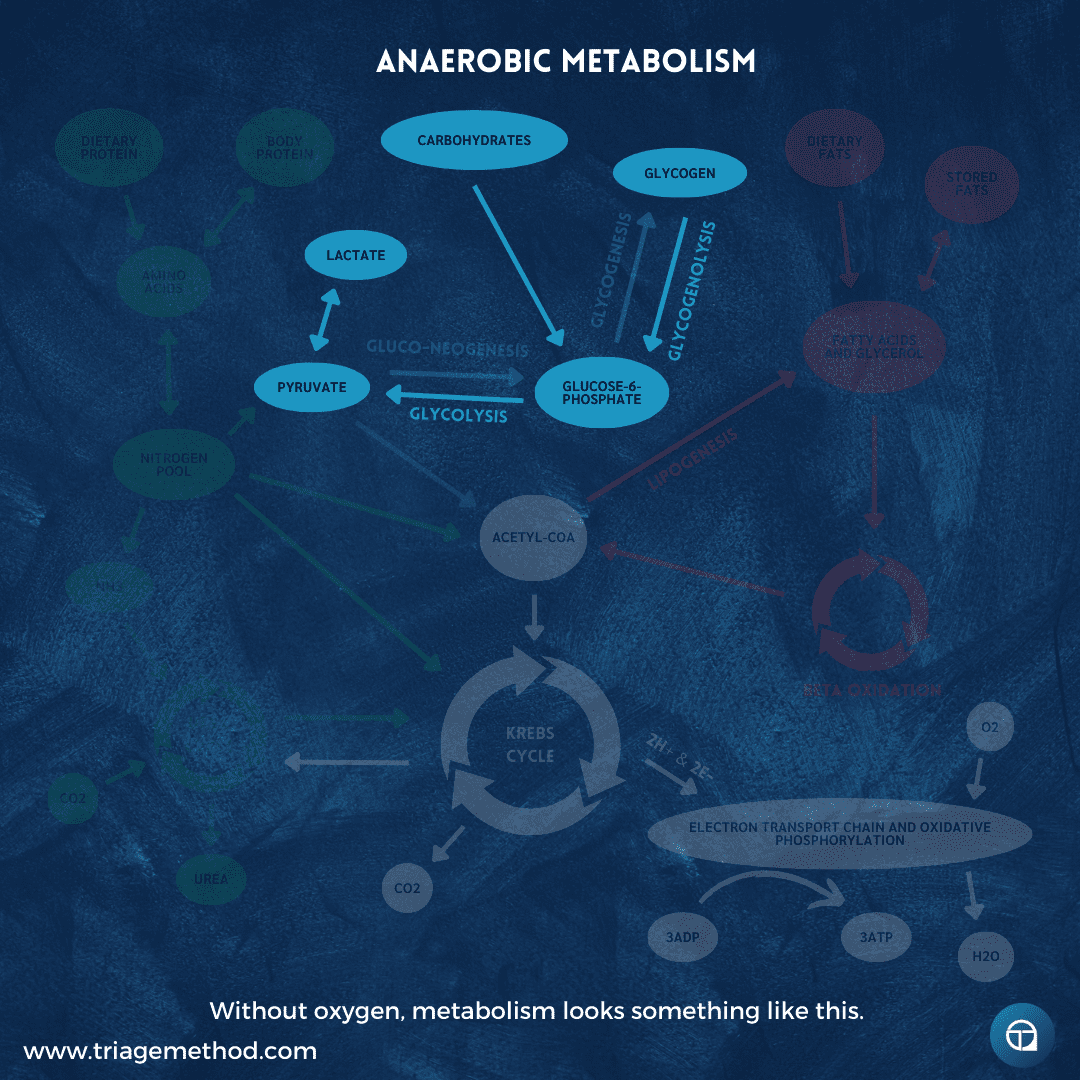
*Note: This is an oversimplification, but does serve the purpose of illustrating the difference between aerobic and anaerobic processes.
While there is quite a bit of overlap between the aerobic system and the anaerobic system, there are a few key distinguishing features of the anaerobic system:
- Energy Speed, Intensity and Duration: The aerobic system is typically thought of as the system that fuels low intensity, steady state activity where oxygen availability is not limited, while the anaerobic system provides rapid energy production for short bursts of high-intensity activity when oxygen availability is limited. The anaerobic system can quickly generate ATP (adenosine triphosphate) without requiring oxygen. This allows for immediate energy availability during short bursts of intense activity, such as sprinting, jumping, or lifting heavy weights. Anaerobic energy production is unsustainable for prolonged periods due to the limited availability of stored energy substrates (glycogen in the cell) and the accumulation of metabolic byproducts (hydrogen ions mainly, which are responsible for that burning sensation). Anaerobic activities typically last from a few seconds to about two minutes before fatigue sets in, depending on the intensity. Anaerobic activities require maximal or near-maximal effort and involve high-intensity muscle contractions. These activities rely on fast-twitch muscle fibres, which are capable of generating rapid force but fatigue quickly compared to slow-twitch fibres.
- Acidosis: The anaerobic breakdown of glucose (anaerobic glycolysis) during intense exercise results in the accumulation of lactate and hydrogen ions. The accumulation of hydrogen ions leads to a drop in pH (increase in acidity) and the sensation of muscle fatigue and burning. Lactate is actually helpful, and serves to reduce the acidic environment, and is transported to the surrounding cells or the liver, where it can be converted to glucose (via the Cori cycle). This process provides a rapid but limited source of ATP for energy production, and unfortunately leads to the accumulation of acidosis which then needs to be recovered by the aerobic system.
- Energy Substrate Utilisation: The primary fuel for anaerobic exercises is ATP, much like with all exercise. Phosphocreatine (PCr) can be used to rapidly regenerate ATP during short bursts of activity, but this is really only a very short term solution (less than 15 seconds of activity really). Fats can’t be broken down fast enough to generate sufficient ATP, and both carbohydrates and fats require oxygen (which can’t be transported fast enough) to be fully broken down to generate ATP via aerobic pathways. However, anaerobic glycolysis can be used to generate ATP, because it breaks down stored glycogen and free glucose in the absence of oxygen. As a result, anaerobic exercise primarily uses carbohydrates as fuel.
- Training Adaptations: While the adaptations you get from aerobic exercise do tend to improve your anaerobic performance, especially your recovery between anaerobic exertions, in general, the adaptations you get from anaerobic exercise don’t generalise as well to aerobic fitness. As the anaerobic system is more constrained by cellular energetics and metabolism, the adaptations to anaerobic exercise tend to be more localised to the cells, whereas aerobic adaptations are much broader (this isn’t 100% true, but it is a decent framework for thinking about this stuff). Anaerobic adaptations also seem to level off much more quickly than aerobic adaptations, and you can generally get incredibly anaerobically fit in 3-6 weeks, but after that, the rate of progress slows significantly. Conversely, the aerobic system seems to have a near infinite capacity to progress, as is generally limited by the amount of time you can dedicate to training it, rather than the specific physiology itself.
- Recovery Time: Following intense anaerobic activity, the body requires a period of recovery to replenish depleted ATP stores, remove metabolic byproducts, and restore pH balance. Recovery time varies depending on the duration and intensity of the activity, however, in general, it takes roughly at least ~3 minutes to recover sufficiently to be able to repeat the anaerobic effort to a similar standard (assuming the first effort was actually sufficiently taxing). This is why individuals involved in sports that require repeated anaerobic efforts (like sprinting) generally have long rest periods between sprints. It is also why individuals who have to engage in repeated sprint efforts without sufficient rest periods notice a steady drop off in performance (i.e. football players notice their subsequent sprint efforts are harder and slower, unless they are incredibly aerobically fit, and even then, there is still a drop off). Generally, anaerobic exercise is also quite neurologically fatiguing too. This is likely due to having to coordinate high force output very fast, along with the generally more significant metabolic disturbances (i.e. cellular glycogen depletion and metabolic waste generation) that occur during anaerobic exercise.
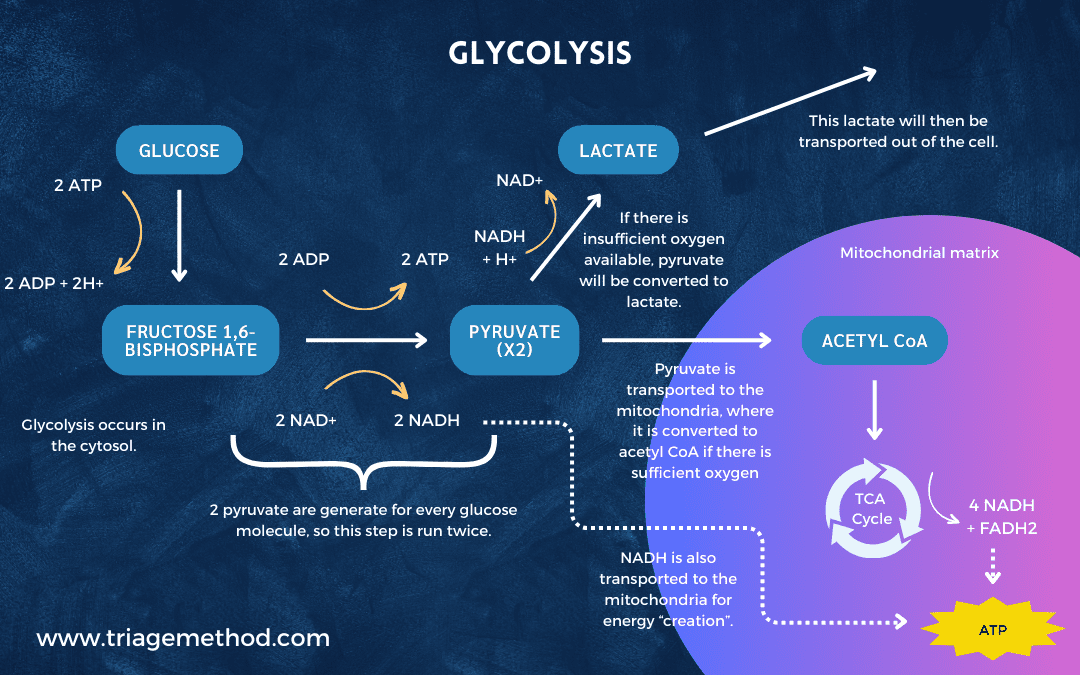
There are a number of factors that influence anaerobic fitness, and these are mostly the same things that influence aerobic fitness. This is especially true when we consider that the aerobic system recovers the anaerobic system, and you can’t really express your true anaerobic fitness without being very aerobically fit. However, while there is quite a lot of crossover, there are some key differences. Anaerobic fitness is generally more efficient in the short term, but in the longer term, it pales in comparison to the aerobic systems efficiency and adaptability.
I often use the analogy of a hybrid petrol-electric car to describe these two systems. For speed off the mark, and for shorter distances, you likely want an electric car (the equivalent of the anaerobic system), but for most other scenarios, especially if you want ease of access to fuel, range (ability to exert energy for long distances and time), speed of refuelling (recovery from exertion), you likely want a petrol car (the equivalent of the aerobic system). However, luckily for us, we can use both systems. We just need to keep in mind that the anaerobic system is less efficient overall, more taxing to use and does require more recovery.
While many of the things that influence the aerobic system overlap with those that influence the anaerobic system, there are some key differences that I want to highlight.
- Muscle Fibre Composition: The proportion of fast-twitch (Type II) muscle fibres relative to slow-twitch (Type I) fibres influences anaerobic performance. Fast-twitch fibres have a greater capacity for rapid force production but fatigue quickly, making them more useful in anaerobic activity. To some degree muscle fibre composition is trainable (i.e. engaging in anaerobic activities increases the size and potentially proportion of fast twitch fibres), however, this is largely genetically determined.
- Strength, Stability and Neuromuscular Coordination: As anaerobic activity generally involves fast muscular contraction, strength, stability and neuromuscular coordination are likely more important for anaerobic activities. While you certainly need to be strong, stable and neuromuscularly coordinated to do aerobic exercise, the overall demands on the body and the forces it has to deal with during anaerobic exercise, generally require greater levels of strength, stability and neuromuscular coordination.
- Energy Substrate Availability: Anaerobic exercise performance is influenced by the availability of glucose more than aerobic performance. While glucose is the preferred fuel for exercise in general, aerobic exercise can actually be done with relatively low glucose availability. Your performance may not be optimal, but it is still possible to perform to a relatively high standard aerobically, without lots of glucose available. However, you simply cannot perform anaerobically without glucose. Anaerobic glycolysis is what is fuelling anaerobic exercise performance, and this only works effectively when there is glucose/glycogen available. The aerobic system is more flexible in its ability to use either fats or carbohydrates, but the anaerobic system can really only use carbohydrates. So if you are trying to optimise your anaerobic performance, then lower carbohydrate diets are unadvisable.
There are some other things that influence the anaerobic system, but we don’t need to dig into them right now. However, before we move on to discussing the other goals people have for training, I just want to note that many individuals focus a lot of their attention and effort on developing their anaerobic system, but not enough on their aerobic system. As a result, despite training incredibly hard, these individuals don’t see the results they desire, and very often athletes who train like this do still get gassed out. The reason they tend to focus so much on the anaerobic system is because training the aerobic system generally takes more time, whereas training the anaerobic system can be done in a shorter time frame.
Training the anaerobic system also tends to feel like you have really pushed yourself hard, whereas very often, training the aerobic system feels like you could have done a little bit more. So, I do want to caution you that most people would be best served primarily focusing on developing their aerobic system, as that is the foundation of fitness.
Peripheral Goals
People do exercise to accomplish other goals too, although often, these aren’t quite as easily defined, categorised or even trained for. So, I am labelling these as peripheral goals, and most of them do actually get adequately developed by simply focusing on the previous goals (for example, flexibility and mobility are improved with good resistance training practices, like you would use to build more muscle and/or strength).
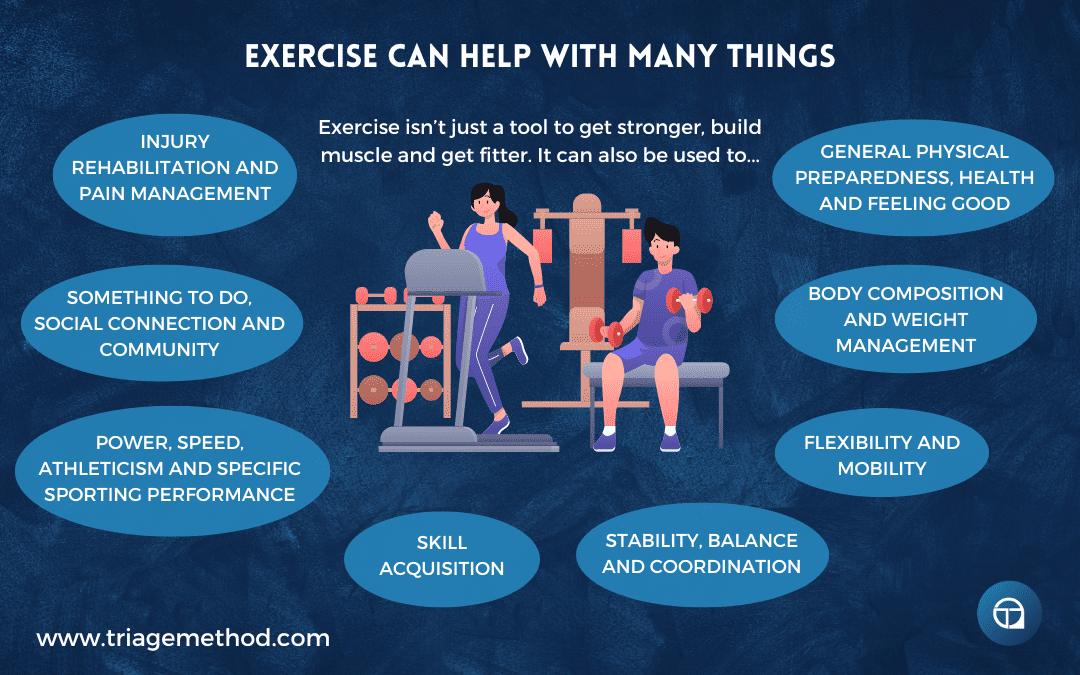
General Physical Preparedness, Health and Feeling Good
Being generally physically prepared for life, being healthy, feeling good, or some combination of these are very common goals. They are probably some of the best reasons to exercise, however, they aren’t easily defined. How much and what kind of training leaves you feeling sufficiently physically prepared, or healthy, or feeling good? So these goals can be hard to really work towards, as we don’t have clear end points.
Having said that, it is actually generally easy enough to design an exercise program that ticks a lot of these boxes. Following the generic exercise guidelines will actually allow you to accomplish most of these, however, you may want to slightly tweak them to really target your specific needs, but by working on the other goals (strength, muscle, aerobic and anaerobic fitness) you should be able to accomplish these goals.
Body Composition and Weight Management
A lot of people exercise primarily with the goal of managing their body composition and/or weight. Despite what some people might say, this is actually a perfectly reasonable reason to exercise. However, this goal is largely accomplished by a combination of exercising to build muscle and a diet that supports fat loss and/or muscle gain. Achieving “optimal body composition” is a more meta goal, and as such, we would actually be better off focusing on the goals that are more process-oriented. To achieve the goal of optimal body composition, you are going to need to focus on improving your muscle size (which will generally require that you get stronger) and getting your body fat to a level that you desire (which is mostly diet). This is generally why we set strength and fitness goals with our body composition focused coaching clients rather than focusing entirely on the actual body composition itself.
Flexibility and Mobility
Improving flexibility and mobility is another very common goal. Flexibility is focused on the passive range of motion you have available to you, while mobility is more concerned with the range of motion that you can actively control and stabilise. A lot of people exercise to increase their flexibility and mobility, and they spend a lot of time stretching, however, unless you are training for a specific sport or endeavour that requires you to have an increased range of motion (i.e. dancing or combat sports) most people can get all of the improvements in flexibility and mobility they want by simply doing exercise through full ranges of motion.
There are still benefits to stretching and doing specific mobility exercises, however, in most cases, simply doing resistance training, and exercise more generally, through full ranges of motion will result in the most robust and consistent increases in flexibility and mobility.
Stability, Balance and Coordination
Stability, balance and coordination is another set of goals that frequently comes up, especially in elderly populations. While you certainly can work on improving these specifically, you do actually get a huge return on investment by simply engaging in generally good exercise practices. Stability and balance are largely a function of muscular strength, as it is your muscles (and skeleton) that serve to stabilise you and allow you to correct your position in space so you can balance effectively. Getting stronger will generally improve stability and balance, and it also tends to improve coordination too.
Skill Acquisition
Many people engage in exercise as a means to improve their skill acquisition in other endeavours (i.e. someone may go to the gym to get stronger in a very specific manner, so they can perform a skill that they want to do or is required for a particular sport) or specifically to improve their skills (i.e. their skill acquisition is just a means to exercise). Largely, skill acquisition is going to be facilitated by simply improving strength, although this may need to be done in a very targeted manner (i.e. you may need to work on strengthening specific muscles or movements). This goal can be very broad or very niche, however, it does come up often enough to warrant including it here.
Power, Speed, Athleticism and Specific Sporting Performance
The goal of developing power, speed, athleticism and/or improving sporting performance is a very common goal. However, it can be quite vague at times, and generally, it is usually accomplished by working on a combination of the other goals such as improving strength, muscle mass, aerobic fitness and/or anaerobic fitness. There may be some specific exercises, techniques and overall program design tweaks that need to be made, depending on the specific goal(s), but generally getting stronger, building some muscle and improving aerobic and anaerobic fitness will be required to really develop optimal sporting performance.
Injury Rehabilitation and Pain Management
This is another very common reason why people exercise. Exercise is a vital part of injury rehabilitation, and is one of the most effective tools we have for pain management (chronic pain at least). A large part of this is just strength development though, and because this is such a large topic, it is beyond the scope of this article. However, if you do need help with this, please do feel free to reach out to us for either coaching, consulting or to just get pointed in the right direction.
Something To Do, Social Connection and Community
A lot of people exercise for something to do, it is fun and you can very often do it in a communal setting and thus make friends doing it, or do it with your friends. I know many people who exercise purely for the social connection and community aspects, and they often don’t care as much about accomplishing other goals outside of enjoying the process with other people.
There are likely many other peripheral goals for exercise, however, we don’t need to cover absolutely every single goal of exercise. Most goals are going to be covered by simply working on getting stronger, building muscle, improving aerobic fitness and/or anaerobic fitness, or indeed, some combination of all of these. So, what tools do we have to accomplish these goals?
The Goals Of Exercise
Understanding the goals of exercise allows us to choose the best tool for the job, and it allows us to better organise and tailor a training program. We can break this down into the more meta goals of improving health, performance and/or body composition. However, we can also break it down into the more exercise specific goals of improving strength, muscle size, aerobic fitness and anaerobic fitness. There are also peripheral goals to these.
Ultimately, being clear on what you are trying to achieve with exercise will allow you to make much better decisions with your exercise program design.
If you would like more help with your training (or nutrition), we do have online coaching spaces available. You can also build your knowledge on all things exercise by interacting with our free content. We recommend reading our foundational nutrition article, along with our foundational articles on sleep and stress management, if you really want to learn more about how to optimise your lifestyle. If you want even more free information on exercise, you can follow us on Instagram, YouTube or listen to the podcast, where we discuss all the little intricacies of exercise. You can always stay up to date with our latest content by subscribing to our newsletter.
Finally, if you want to learn how to coach nutrition, then consider our Nutrition Coach Certification course and if you want to learn to get better at exercise program design, then consider our course on exercise program design. We do have other courses available too. If you don’t understand something, or you just need clarification, you can always reach out to us on Instagram or via email.
The previous article in this series is about why exercise is so important and the next article in this series is about the different types of exercise, if you are interested in continuing to learn about exercise program design. You can also go to our exercise hub to find more exercise content.
References and Further Reading
Ruegsegger GN, Booth FW. Health Benefits of Exercise. Cold Spring Harb Perspect Med. 2018;8(7):a029694. Published 2018 Jul 2. doi:10.1101/cshperspect.a029694 https://www.ncbi.nlm.nih.gov/pmc/articles/PMC6027933/
Posadzki P, Pieper D, Bajpai R, et al. Exercise/physical activity and health outcomes: an overview of Cochrane systematic reviews. BMC Public Health. 2020;20(1):1724. Published 2020 Nov 16. doi:10.1186/s12889-020-09855-3 https://pubmed.ncbi.nlm.nih.gov/33198717/
Warburton DER, Bredin SSD. Health benefits of physical activity: a systematic review of current systematic reviews. Curr Opin Cardiol. 2017;32(5):541-556. doi:10.1097/HCO.0000000000000437 https://pubmed.ncbi.nlm.nih.gov/28708630/
Kramer A. An Overview of the Beneficial Effects of Exercise on Health and Performance. Adv Exp Med Biol. 2020;1228:3-22. doi:10.1007/978-981-15-1792-1_1 https://pubmed.ncbi.nlm.nih.gov/32342447/
Qiu Y, Fernández-García B, Lehmann HI, et al. Exercise sustains the hallmarks of health. J Sport Health Sci. 2023;12(1):8-35. doi:10.1016/j.jshs.2022.10.003 https://www.ncbi.nlm.nih.gov/pmc/articles/PMC9923435/
Thompson WR, Sallis R, Joy E, Jaworski CA, Stuhr RM, Trilk JL. Exercise Is Medicine. Am J Lifestyle Med. 2020;14(5):511-523. Published 2020 Apr 22. doi:10.1177/1559827620912192 https://www.ncbi.nlm.nih.gov/pmc/articles/PMC7444006/
Chen, YT., Fredericson, M., Matheson, G. et al. Exercise is Medicine. Curr Phys Med Rehabil Rep 1, 48–56 (2013). https://link.springer.com/article/10.1007/s40141-013-0006-1
Sallis RE. Exercise is medicine and physicians need to prescribe it!. Br J Sports Med. 2009;43(1):3-4. doi:10.1136/bjsm.2008.054825 https://pubmed.ncbi.nlm.nih.gov/18971243/
Sallis R. Exercise is medicine: a call to action for physicians to assess and prescribe exercise. Phys Sportsmed. 2015;43(1):22-26. doi:10.1080/00913847.2015.1001938 https://pubmed.ncbi.nlm.nih.gov/25684558/
Li J, Qiu H, Li J. Exercise is medicine. Front Aging Neurosci. 2023;15:1129221. Published 2023 Jan 30. doi:10.3389/fnagi.2023.1129221 https://www.ncbi.nlm.nih.gov/pmc/articles/PMC9922893/
Langan SP, Grosicki GJ. Exercise Is Medicine…and the Dose Matters. Front Physiol. 2021;12:660818. Published 2021 May 12. doi:10.3389/fphys.2021.660818 https://pubmed.ncbi.nlm.nih.gov/34054576/
Anderson E, Durstine JL. Physical activity, exercise, and chronic diseases: A brief review. Sports Med Health Sci. 2019;1(1):3-10. Published 2019 Sep 10. doi:10.1016/j.smhs.2019.08.006 https://www.ncbi.nlm.nih.gov/pmc/articles/PMC9219321/
Hamer M, Endrighi R, Poole L. Physical activity, stress reduction, and mood: insight into immunological mechanisms. Methods Mol Biol. 2012;934:89-102. doi:10.1007/978-1-62703-071-7_5 https://pubmed.ncbi.nlm.nih.gov/22933142/
El-Kotob R, Ponzano M, Chaput JP, et al. Resistance training and health in adults: an overview of systematic reviews. Appl Physiol Nutr Metab. 2020;45(10 (Suppl. 2)):S165-S179. doi:10.1139/apnm-2020-0245 https://pubmed.ncbi.nlm.nih.gov/33054335/
Shailendra P, Baldock KL, Li LSK, Bennie JA, Boyle T. Resistance Training and Mortality Risk: A Systematic Review and Meta-Analysis. Am J Prev Med. 2022;63(2):277-285. doi:10.1016/j.amepre.2022.03.020 https://pubmed.ncbi.nlm.nih.gov/35599175/
Paluch AE, Boyer WR, Franklin BA, et al. Resistance Exercise Training in Individuals With and Without Cardiovascular Disease: 2023 Update: A Scientific Statement From the American Heart Association. Circulation. 2024;149(3):e217-e231. doi:10.1161/CIR.0000000000001189 https://pubmed.ncbi.nlm.nih.gov/38059362/
Kraemer WJ, Ratamess NA, French DN. Resistance training for health and performance. Curr Sports Med Rep. 2002;1(3):165-171. doi:10.1249/00149619-200206000-00007 https://pubmed.ncbi.nlm.nih.gov/12831709/
Strasser B, Volaklis K, Fuchs D, Burtscher M. Role of Dietary Protein and Muscular Fitness on Longevity and Aging. Aging Dis. 2018;9(1):119-132. Published 2018 Feb 1. doi:10.14336/AD.2017.0202 https://www.ncbi.nlm.nih.gov/pmc/articles/PMC5772850/
McLeod M, Breen L, Hamilton DL, Philp A. Live strong and prosper: the importance of skeletal muscle strength for healthy ageing. Biogerontology. 2016;17(3):497-510. doi:10.1007/s10522-015-9631-7 https://www.ncbi.nlm.nih.gov/pmc/articles/PMC4889643/
Witard OC, McGlory C, Hamilton DL, Phillips SM. Growing older with health and vitality: a nexus of physical activity, exercise and nutrition. Biogerontology. 2016;17(3):529-546. doi:10.1007/s10522-016-9637-9 https://pubmed.ncbi.nlm.nih.gov/26878863/
Chen L, Nelson DR, Zhao Y, Cui Z, Johnston JA. Relationship between muscle mass and muscle strength, and the impact of comorbidities: a population-based, cross-sectional study of older adults in the United States. BMC Geriatr. 2013;13:74. Published 2013 Jul 16. doi:10.1186/1471-2318-13-74 https://www.ncbi.nlm.nih.gov/pmc/articles/PMC3765109/
Srikanthan P, Karlamangla AS. Muscle mass index as a predictor of longevity in older adults. Am J Med. 2014;127(6):547-553. doi:10.1016/j.amjmed.2014.02.007 https://pubmed.ncbi.nlm.nih.gov/24561114/
Moghetti P, Bacchi E, Brangani C, Donà S, Negri C. Metabolic Effects of Exercise. Front Horm Res. 2016;47:44-57. doi:10.1159/000445156 https://pubmed.ncbi.nlm.nih.gov/27348753/
Hong AR, Kim SW. Effects of Resistance Exercise on Bone Health. Endocrinol Metab (Seoul). 2018;33(4):435-444. doi:10.3803/EnM.2018.33.4.435 https://www.ncbi.nlm.nih.gov/pmc/articles/PMC6279907/
Manaye S, Cheran K, Murthy C, et al. The Role of High-intensity and High-impact Exercises in Improving Bone Health in Postmenopausal Women: A Systematic Review. Cureus. 2023;15(2):e34644. Published 2023 Feb 5. doi:10.7759/cureus.34644 https://www.ncbi.nlm.nih.gov/pmc/articles/PMC9990535/
Liu Y, Lee DC, Li Y, et al. Associations of Resistance Exercise with Cardiovascular Disease Morbidity and Mortality. Med Sci Sports Exerc. 2019;51(3):499-508. doi:10.1249/MSS.0000000000001822 https://www.ncbi.nlm.nih.gov/pmc/articles/PMC7385554/
Lee DC, Brellenthin AG, Lanningham-Foster LM, Kohut ML, Li Y. Aerobic, resistance, or combined exercise training and cardiovascular risk profile in overweight or obese adults: the CardioRACE trial. Eur Heart J. 2024;45(13):1127-1142. doi:10.1093/eurheartj/ehad827 https://pubmed.ncbi.nlm.nih.gov/38233024/
Halle M, Papadakis M. A new dawn of managing cardiovascular risk in obesity: the importance of combining lifestyle intervention and medication. Eur Heart J. 2024;45(13):1143-1145. doi:10.1093/eurheartj/ehae091 https://pubmed.ncbi.nlm.nih.gov/38366823/
Kirkman DL, Lee DC, Carbone S. Resistance exercise for cardiac rehabilitation. Prog Cardiovasc Dis. 2022;70:66-72. doi:10.1016/j.pcad.2022.01.004 https://www.ncbi.nlm.nih.gov/pmc/articles/PMC8930531/
Westcott WL. Resistance training is medicine: effects of strength training on health. Curr Sports Med Rep. 2012;11(4):209-216. doi:10.1249/JSR.0b013e31825dabb8 https://pubmed.ncbi.nlm.nih.gov/22777332/
Lavie CJ, Lee DC, Sui X, et al. Effects of Running on Chronic Diseases and Cardiovascular and All-Cause Mortality. Mayo Clin Proc. 2015;90(11):1541-1552. doi:10.1016/j.mayocp.2015.08.001 https://pubmed.ncbi.nlm.nih.gov/26362561/
Hackett DA. Lung Function and Respiratory Muscle Adaptations of Endurance- and Strength-Trained Males. Sports (Basel). 2020;8(12):160. Published 2020 Dec 10. doi:10.3390/sports8120160 https://www.ncbi.nlm.nih.gov/pmc/articles/PMC7764033/
Hellsten Y, Nyberg M. Cardiovascular Adaptations to Exercise Training. Compr Physiol. 2015;6(1):1-32. Published 2015 Dec 15. doi:10.1002/cphy.c140080 https://pubmed.ncbi.nlm.nih.gov/26756625/
Lässing J, Maudrich T, Kenville R, et al. Intensity-dependent cardiopulmonary response during and after strength training. Sci Rep. 2023;13(1):6632. Published 2023 Apr 24. doi:10.1038/s41598-023-33873-x https://pubmed.ncbi.nlm.nih.gov/37095279/
Benck LR, Cuttica MJ, Colangelo LA, et al. Association between Cardiorespiratory Fitness and Lung Health from Young Adulthood to Middle Age. Am J Respir Crit Care Med. 2017;195(9):1236-1243. doi:10.1164/rccm.201610-2089OC https://www.ncbi.nlm.nih.gov/pmc/articles/PMC5439017/
Reimers AK, Knapp G, Reimers CD. Effects of Exercise on the Resting Heart Rate: A Systematic Review and Meta-Analysis of Interventional Studies. J Clin Med. 2018;7(12):503. Published 2018 Dec 1. doi:10.3390/jcm7120503 https://www.ncbi.nlm.nih.gov/pmc/articles/PMC6306777/
Gielen S, Schuler G, Adams V. Cardiovascular effects of exercise training: molecular mechanisms. Circulation. 2010;122(12):1221-1238. doi:10.1161/CIRCULATIONAHA.110.939959 https://pubmed.ncbi.nlm.nih.gov/20855669/
Muscella A, Stefàno E, Marsigliante S. The effects of exercise training on lipid metabolism and coronary heart disease. Am J Physiol Heart Circ Physiol. 2020;319(1):H76-H88. doi:10.1152/ajpheart.00708.2019 https://pubmed.ncbi.nlm.nih.gov/32442027/
Wilson MG, Ellison GM, Cable NT. Basic science behind the cardiovascular benefits of exercise. Heart. 2015;101(10):758-765. doi:10.1136/heartjnl-2014-306596 https://pubmed.ncbi.nlm.nih.gov/25911667/
Franklin BA, Eijsvogels TMH, Pandey A, Quindry J, Toth PP. Physical activity, cardiorespiratory fitness, and cardiovascular health: A clinical practice statement of the ASPC Part I: Bioenergetics, contemporary physical activity recommendations, benefits, risks, extreme exercise regimens, potential maladaptations. Am J Prev Cardiol. 2022;12:100424. Published 2022 Oct 13. doi:10.1016/j.ajpc.2022.100424 https://pubmed.ncbi.nlm.nih.gov/36281324/
Rao P, Belanger MJ, Robbins JM. Exercise, Physical Activity, and Cardiometabolic Health: Insights into the Prevention and Treatment of Cardiometabolic Diseases. Cardiol Rev. 2022;30(4):167-178. doi:10.1097/CRD.0000000000000416 https://www.ncbi.nlm.nih.gov/pmc/articles/PMC8920940/
Myers J, Kokkinos P, Nyelin E. Physical Activity, Cardiorespiratory Fitness, and the Metabolic Syndrome. Nutrients. 2019;11(7):1652. Published 2019 Jul 19. doi:10.3390/nu11071652 https://www.ncbi.nlm.nih.gov/pmc/articles/PMC6683051/
Giallauria F, Strisciuglio T, Cuomo G, et al. Exercise Training: The Holistic Approach in Cardiovascular Prevention. High Blood Press Cardiovasc Prev. 2021;28(6):561-577. doi:10.1007/s40292-021-00482-6 https://www.ncbi.nlm.nih.gov/pmc/articles/PMC8590648/
Franklin BA, Wedig IJ, Sallis RE, Lavie CJ, Elmer SJ. Physical Activity and Cardiorespiratory Fitness as Modulators of Health Outcomes: A Compelling Research-Based Case Presented to the Medical Community. Mayo Clin Proc. 2023;98(2):316-331. doi:10.1016/j.mayocp.2022.09.011 https://pubmed.ncbi.nlm.nih.gov/36737120/
Reimers CD, Knapp G, Reimers AK. Does physical activity increase life expectancy? A review of the literature. J Aging Res. 2012;2012:243958. doi:10.1155/2012/243958 https://www.ncbi.nlm.nih.gov/pmc/articles/PMC3395188/
Santos AC, Willumsen J, Meheus F, Ilbawi A, Bull FC. The cost of inaction on physical inactivity to public health-care systems: a population-attributable fraction analysis. Lancet Glob Health. 2023;11(1):e32-e39. doi:10.1016/S2214-109X(22)00464-8 https://pubmed.ncbi.nlm.nih.gov/36480931/
Lee IM, Shiroma EJ, Lobelo F, et al. Effect of physical inactivity on major non-communicable diseases worldwide: an analysis of burden of disease and life expectancy. Lancet. 2012;380(9838):219-229. doi:10.1016/S0140-6736(12)61031-9 https://pubmed.ncbi.nlm.nih.gov/22818936/
Guthold R, Stevens GA, Riley LM, Bull FC. Worldwide trends in insufficient physical activity from 2001 to 2016: a pooled analysis of 358 population-based surveys with 1·9 million participants [published correction appears in Lancet Glob Health. 2019 Jan;7(1):e36]. Lancet Glob Health. 2018;6(10):e1077-e1086. doi:10.1016/S2214-109X(18)30357-7 https://pubmed.ncbi.nlm.nih.gov/30193830/
Duggal NA, Niemiro G, Harridge SDR, Simpson RJ, Lord JM. Can physical activity ameliorate immunosenescence and thereby reduce age-related multi-morbidity?. Nat Rev Immunol. 2019;19(9):563-572. doi:10.1038/s41577-019-0177-9 https://pubmed.ncbi.nlm.nih.gov/31175337/
Nusselder WJ, Franco OH, Peeters A, Mackenbach JP. Living healthier for longer: comparative effects of three heart-healthy behaviors on life expectancy with and without cardiovascular disease. BMC Public Health. 2009;9:487. Published 2009 Dec 24. doi:10.1186/1471-2458-9-487 https://www.ncbi.nlm.nih.gov/pmc/articles/PMC2813239/
Gremeaux V, Gayda M, Lepers R, Sosner P, Juneau M, Nigam A. Exercise and longevity. Maturitas. 2012;73(4):312-317. doi:10.1016/j.maturitas.2012.09.012 https://pubmed.ncbi.nlm.nih.gov/23063021/
Wen CP, Wai JP, Tsai MK, et al. Minimum amount of physical activity for reduced mortality and extended life expectancy: a prospective cohort study. Lancet. 2011;378(9798):1244-1253. doi:10.1016/S0140-6736(11)60749-6 https://pubmed.ncbi.nlm.nih.gov/21846575/
Kopp M, Burtscher M. Aiming at Optimal Physical Activity for Longevity (OPAL). Sports Med Open. 2021;7(1):70. Published 2021 Oct 9. doi:10.1186/s40798-021-00360-4 https://www.ncbi.nlm.nih.gov/pmc/articles/PMC8502188/
Lee IM, Paffenbarger RS Jr, Hennekens CH. Physical activity, physical fitness and longevity. Aging (Milano). 1997;9(1-2):2-11. doi:10.1007/BF03340123 https://pubmed.ncbi.nlm.nih.gov/9177581/
Sheehan CM, Li L. Associations of Exercise Types with All-Cause Mortality among U.S. Adults. Med Sci Sports Exerc. 2020;52(12):2554-2562. doi:10.1249/MSS.0000000000002406 https://pubmed.ncbi.nlm.nih.gov/32520868/
Lear SA, Hu W, Rangarajan S, et al. The effect of physical activity on mortality and cardiovascular disease in 130 000 people from 17 high-income, middle-income, and low-income countries: the PURE study [published correction appears in Lancet. 2017 Dec 16;390(10113):2626]. Lancet. 2017;390(10113):2643-2654. doi:10.1016/S0140-6736(17)31634-3 https://pubmed.ncbi.nlm.nih.gov/28943267/
Bull FC, Al-Ansari SS, Biddle S, et al. World Health Organization 2020 guidelines on physical activity and sedentary behaviour. Br J Sports Med. 2020;54(24):1451-1462. doi:10.1136/bjsports-2020-102955 https://pubmed.ncbi.nlm.nih.gov/33239350/
Piercy KL, Troiano RP, Ballard RM, et al. The Physical Activity Guidelines for Americans. JAMA. 2018;320(19):2020-2028. doi:10.1001/jama.2018.14854 https://pubmed.ncbi.nlm.nih.gov/30418471/
O’Donovan G, Blazevich AJ, Boreham C, et al. The ABC of Physical Activity for Health: a consensus statement from the British Association of Sport and Exercise Sciences. J Sports Sci. 2010;28(6):573-591. doi:10.1080/02640411003671212 https://pubmed.ncbi.nlm.nih.gov/20401789/
Haskell WL, Lee IM, Pate RR, et al. Physical activity and public health: updated recommendation for adults from the American College of Sports Medicine and the American Heart Association. Med Sci Sports Exerc. 2007;39(8):1423-1434. doi:10.1249/mss.0b013e3180616b27 https://pubmed.ncbi.nlm.nih.gov/17762377/
Du Y, Liu B, Sun Y, Snetselaar LG, Wallace RB, Bao W. Trends in Adherence to the Physical Activity Guidelines for Americans for Aerobic Activity and Time Spent on Sedentary Behavior Among US Adults, 2007 to 2016. JAMA Netw Open. 2019;2(7):e197597. Published 2019 Jul 3. doi:10.1001/jamanetworkopen.2019.7597 https://pubmed.ncbi.nlm.nih.gov/31348504/
Ding D, Mutrie N, Bauman A, Pratt M, Hallal PRC, Powell KE. Physical activity guidelines 2020: comprehensive and inclusive recommendations to activate populations. Lancet. 2020;396(10265):1780-1782. doi:10.1016/S0140-6736(20)32229-7 https://pubmed.ncbi.nlm.nih.gov/33248019/
DiPietro L, Al-Ansari SS, Biddle SJH, et al. Advancing the global physical activity agenda: recommendations for future research by the 2020 WHO physical activity and sedentary behavior guidelines development group. Int J Behav Nutr Phys Act. 2020;17(1):143. Published 2020 Nov 26. doi:10.1186/s12966-020-01042-2 https://pubmed.ncbi.nlm.nih.gov/33239105/
Burtscher J, Burtscher M. Run for your life: tweaking the weekly physical activity volume for longevity. Br J Sports Med. 2020;54(13):759-760. doi:10.1136/bjsports-2019-101350 https://pubmed.ncbi.nlm.nih.gov/31630092/
Marin-Couture E, Pérusse L, Tremblay A. The fit-active profile to better reflect the benefits of a lifelong vigorous physical activity participation: mini-review of literature and population data. Appl Physiol Nutr Metab. 2021;46(7):763-770. doi:10.1139/apnm-2020-1109 https://pubmed.ncbi.nlm.nih.gov/33667123/
O’Keefe JH, O’Keefe EL, Lavie CJ. The Goldilocks Zone for Exercise: Not Too Little, Not Too Much. Mo Med. 2018;115(2):98-105. https://www.ncbi.nlm.nih.gov/pmc/articles/PMC6139866/
O’Keefe JH, O’Keefe EL, Eckert R, Lavie CJ. Training Strategies to Optimize Cardiovascular Durability and Life Expectancy. Mo Med. 2023;120(2):155-162. https://www.ncbi.nlm.nih.gov/pmc/articles/PMC10121111/
Lee DH, Rezende LFM, Joh HK, et al. Long-Term Leisure-Time Physical Activity Intensity and All-Cause and Cause-Specific Mortality: A Prospective Cohort of US Adults. Circulation. 2022;146(7):523-534. doi:10.1161/CIRCULATIONAHA.121.058162 https://www.ncbi.nlm.nih.gov/pmc/articles/PMC9378548/
Master H, Annis J, Huang S, et al. Association of step counts over time with the risk of chronic disease in the All of Us Research Program [published correction appears in Nat Med. 2023 Dec;29(12):3270]. Nat Med. 2022;28(11):2301-2308. doi:10.1038/s41591-022-02012-w https://pubmed.ncbi.nlm.nih.gov/36216933/
Choi BC, Pak AW, Choi JC, Choi EC. Daily step goal of 10,000 steps: a literature review. Clin Invest Med. 2007;30(3):E146-E151. doi:10.25011/cim.v30i3.1083 https://pubmed.ncbi.nlm.nih.gov/17716553/
Tudor-Locke C, Bassett DR Jr. How many steps/day are enough? Preliminary pedometer indices for public health. Sports Med. 2004;34(1):1-8. doi:10.2165/00007256-200434010-00001 https://pubmed.ncbi.nlm.nih.gov/14715035/
Paluch AE, Bajpai S, Bassett DR, et al. Daily steps and all-cause mortality: a meta-analysis of 15 international cohorts. Lancet Public Health. 2022;7(3):e219-e228. doi:10.1016/S2468-2667(21)00302-9 https://pubmed.ncbi.nlm.nih.gov/35247352/
Hall KS, Hyde ET, Bassett DR, et al. Systematic review of the prospective association of daily step counts with risk of mortality, cardiovascular disease, and dysglycemia. Int J Behav Nutr Phys Act. 2020;17(1):78. Published 2020 Jun 20. doi:10.1186/s12966-020-00978-9 https://www.ncbi.nlm.nih.gov/pmc/articles/PMC7305604/
Yuenyongchaiwat K. Effects of 10,000 steps a day on physical and mental health in overweight participants in a community setting: a preliminary study. Braz J Phys Ther. 2016;20(4):367-373. doi:10.1590/bjpt-rbf.2014.0160 https://pubmed.ncbi.nlm.nih.gov/27556393/
Ahmadi MN, Rezende LFM, Ferrari G, Del Pozo Cruz B, Lee IM, Stamatakis E. Do the associations of daily steps with mortality and incident cardiovascular disease differ by sedentary time levels? A device-based cohort study. Br J Sports Med. 2024;58(5):261-268. Published 2024 Mar 8. doi:10.1136/bjsports-2023-107221 https://pubmed.ncbi.nlm.nih.gov/38442950/
Castres I, Tourny C, Lemaitre F, Coquart J. Impact of a walking program of 10,000 steps per day and dietary counseling on health-related quality of life, energy expenditure and anthropometric parameters in obese subjects. J Endocrinol Invest. 2017;40(2):135-141. doi:10.1007/s40618-016-0530-9 https://pubmed.ncbi.nlm.nih.gov/27600387/
Morgan AL, Tobar DA, Snyder L. Walking toward a new me: the impact of prescribed walking 10,000 steps/day on physical and psychological well-being. J Phys Act Health. 2010;7(3):299-307. doi:10.1123/jpah.7.3.299 https://pubmed.ncbi.nlm.nih.gov/20551485/
Rivera-Brown AM, Frontera WR. Principles of exercise physiology: responses to acute exercise and long-term adaptations to training. PM R. 2012;4(11):797-804. doi:10.1016/j.pmrj.2012.10.007 https://pubmed.ncbi.nlm.nih.gov/23174541/
Kiens B, Richter EA, Wojtaszewski JF. Exercise physiology: from performance studies to muscle physiology and cardiovascular adaptations. J Appl Physiol (1985). 2014;117(9):943-944. doi:10.1152/japplphysiol.00874.2014 https://pubmed.ncbi.nlm.nih.gov/25277739/
Ferretti G, Fagoni N, Taboni A, Vinetti G, di Prampero PE. A century of exercise physiology: key concepts on coupling respiratory oxygen flow to muscle energy demand during exercise. Eur J Appl Physiol. 2022;122(6):1317-1365. doi:10.1007/s00421-022-04901-x https://pubmed.ncbi.nlm.nih.gov/35217911/
Pedersen BK. The Physiology of Optimizing Health with a Focus on Exercise as Medicine. Annu Rev Physiol. 2019;81:607-627. doi:10.1146/annurev-physiol-020518-114339 https://pubmed.ncbi.nlm.nih.gov/30526319/
Powers SK, Hogan MC. Advances in exercise physiology: exercise and health. J Physiol. 2021;599(3):769-770. doi:10.1113/JP281003 https://pubmed.ncbi.nlm.nih.gov/33521984/
Irvin CG. Exercise physiology. Allergy Asthma Proc. 1996;17(6):327-330. doi:10.2500/108854196778606356 https://pubmed.ncbi.nlm.nih.gov/8993725/
Guan Y, Yan Z. Molecular Mechanisms of Exercise and Healthspan. Cells. 2022;11(5):872. Published 2022 Mar 3. doi:10.3390/cells11050872 https://pubmed.ncbi.nlm.nih.gov/35269492/
Furrer R, Hawley JA, Handschin C. The molecular athlete: exercise physiology from mechanisms to medals. Physiol Rev. 2023;103(3):1693-1787. doi:10.1152/physrev.00017.2022 https://www.ncbi.nlm.nih.gov/pmc/articles/PMC10110736/
Roberts FL, Markby GR. New Insights into Molecular Mechanisms Mediating Adaptation to Exercise; A Review Focusing on Mitochondrial Biogenesis, Mitochondrial Function, Mitophagy and Autophagy. Cells. 2021;10(10):2639. Published 2021 Oct 2. doi:10.3390/cells10102639 https://www.ncbi.nlm.nih.gov/pmc/articles/PMC8533934/
Baar K. Using molecular biology to maximize concurrent training. Sports Med. 2014;44 Suppl 2(Suppl 2):S117-S125. doi:10.1007/s40279-014-0252-0 https://pubmed.ncbi.nlm.nih.gov/25355186/

